In European art dance, one stands above the rest: ballet. The power of this dance form lies in its narrative of centuries of unbroken artistic development, beginning with the European courts of the sixteenth century and continuing to this day. However, a closer look at the history of ballet reveals varying aesthetic ideals and different ways of understanding the form. The content, meaning and ideals of the art form have varied greatly over different stylistic periods and due to prevalent fashion – or to very local circumstances. Even today, ballet is not a unified form of dance in terms of technique, aesthetics or even its audiences.
From a Court Dance to an Art
The history of ballet begins in the Early Modern era, in the city-states of what is now Italy. The balls of wealthy families (It. ballo, from which the word “ballet” derives) were glamorous events lasting up to several days, where guests were entertained with shows and performances. Like martial arts, dancing was an important factor of upper-class body culture; smooth, graceful and controlled movement was seen as demonstrating desirable aristocratic traits. Dance was focal in the representation of nobility and civilisation: the alliance of money and aristocratic behaviour could outrank inherited nobility. Only the wealthiest could afford to spend their time learning dance patterns, refining gestures, designing costumes and attending parties lasting several days.
The ballet de cour, or court ballet proper, developed in France at the turn of the fifteenth century. In 1533, the art-loving King of France, Francis I, married his second son Henry to the rich commoner Catherine de’ Medici, whose family ruled the city of Florence. However, when Henry II inherited the throne, Catherine became Queen of France and continued Francis I’s policy of favouring the arts. Catherine spent generously on art and court entertainments, and the development of court ballet by the mid-1500s can be attributed largely to her patronage.
The ideals of court ballet were based on classical poetics. This was a Renaissance version of ancient Greek and Roman artistic thought – the word “renaissance” (It. rinascimento) refers specifically to the “rebirth” of ancient culture. Perhaps the most famous example of a court ballet was the Ballet Comique de la Reine (“Comic Ballet of the Queen”), commissioned by Catherine de’ Medici in 1581 for the wedding of her favourite, the Duke of Joyeuse, with dances by Balthazar Beaujoyeulx (d. 1587). This ballet was structured around academic principles of the proper relationship between poetry, music, dance and scenery formulated by Jean-Antoine de Baïf (1532–1589). The word comique in the title referred to the division between tragedy and comedy, with the former ending in sublime sadness and the latter in happiness, as befits a wedding. The subject of the ballet was Circe, the enchantress of the Odyssey, who symbolised discord. Vanquishing Circe led to peace and reconciliation. The happy ending thus referred not only to the celebrated political harmony that would be achieved through the union between the two families, but also to the hope of future peace in a France torn between religious and political factions. (This was not to be: only a few years later, the Duke of Joyeuse was responsible for the massacre of Saint-Éloi, in which an estimated 800 Huguenots were killed by Catholics.) The five-and-a-half-hour performance was attended, as was typical of a court ballet, by the entire wedding party, including the ruling couple.
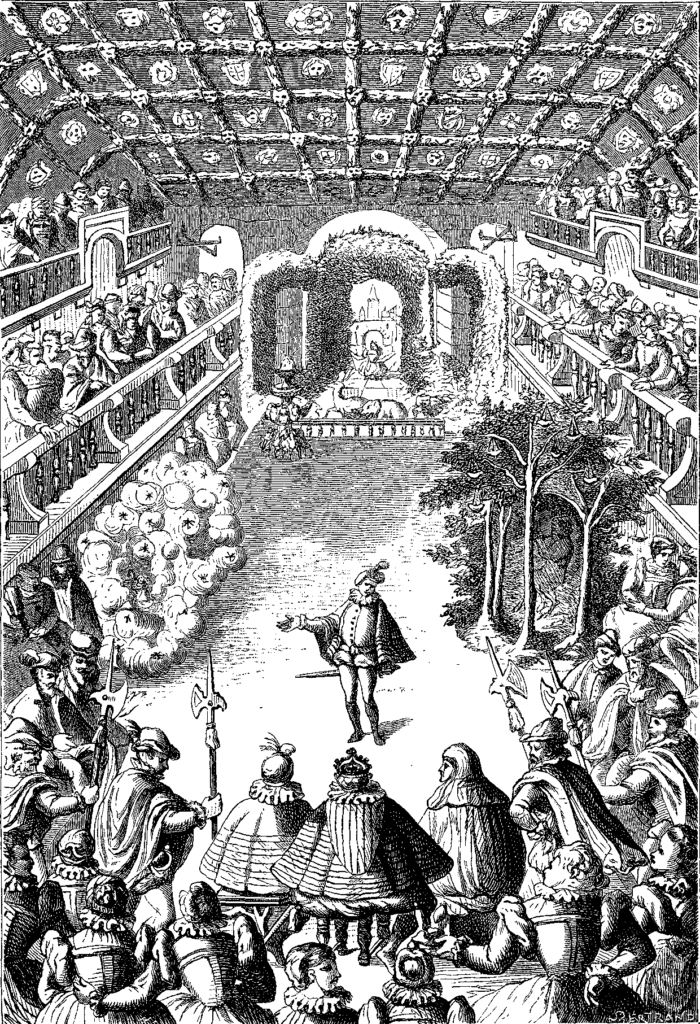
In court ballet, the stage was simply an area for dancing. The spectators watched the movements of the nobles and/or the specially hired performers from the sides. The performances included spectacular sets and costumes and were accompanied by an orchestra. The dancing masters created complex, symbolic patterns (Fr. figures) in which the dancers positioned themselves in relation to each other and to the stage space so that when they stopped their bodies formed patterns: geometric ideal shapes (triangles or circles), letters or Roman numerals. As this was court entertainment, monograms of rulers were popular climaxes in these performances.
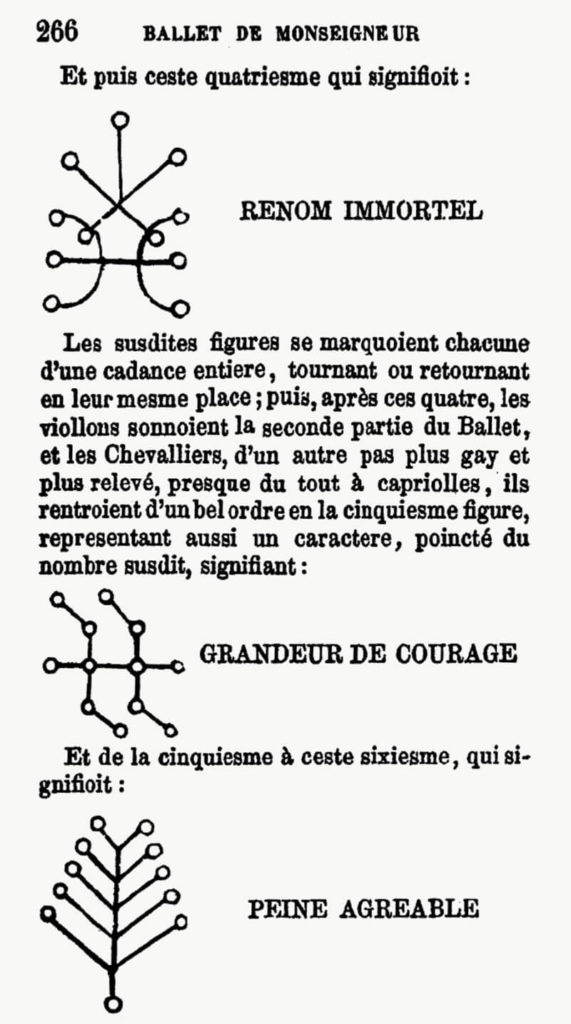
In the sixteenth century, the arts had not yet differentiated to the forms they have today, and ballet did not yet mean a codified technique based on particular positions. Many of the performances called ballets at the time included poetry, song and fireworks, while dancing was often part of any celebration. Little is known about how court ballets were rehearsed: obviously, the dancers rehearsed their parts, as in the Early Modern period, the presentation of nobility was becoming increasingly important. It is also known that professionals were used in these ensembles especially for acrobatic parts intended to amaze the audience. However, all trades were learned as “secrets,” either in the family circle or by joining a guild, so little survives of the pedagogy of professional performers.
The court ballet was first and foremost a stage for the power of the ruler and the higher nobility; it reflected their world view and their position in society. Since dance represented the triumph of civilisation and good manners over barbarism, colonial power was from the first a central theme in court ballets. As early as the sixteenth century, French kings used ballets to celebrate their conquests on other continents – for example, Le Grand Ballet des étrangers (“The Foreigners’ Grand Ballet,” 1598) illustrated the French victory over the Native Americans. As court ballets became increasingly grand, exotic “savages” were specially brought over to perform in these European spectacles. In the seventeenth century, these performances became a way of justifying colonialism and celebrating colonial conquests.[1] Indeed, if one characteristic unifies the centuries-old history of ballet, it is its alliance with colonialism. (see Orientalism in Ballet)
From Baroque Theatre Space to Horseshoe Theatres
In the late seventeenth century, as European rulers increasingly concentrated their power, court ballet offered the nobility a means of countering their relative decline in status. Louis XIV, whose reign lasted from 1643 to 1715, used court ballet as a symbol of his position. He enjoyed performing in ballets, and it is claimed that his nickname, the Sun King, was partly derived from his role as the sun god Apollo in the twelve-hour Ballet Royal de la Nuict (“Royal Ballet of Night,” 1653). Certainly, Louis chose the sun as his symbol, and suns appeared repeatedly in the decoration of the palace he built at Versailles. The king represented his autocratic power as sun-like, as the centre of the universe, and himself as a light-bringer to his subjects.[2]
As the performed parts in court ballets became more and more complex, professional dancers were increasingly hired to perform them. The professionalisation of dance meant a proliferation of both dance training and published texts on dance. In 1661, the first academy of dance was founded in Paris, and by the 1680s, ballet had finally become a professionally performed, staged art form; instead of participating, nobles watched non-nobles dancing. The teaching of partnered dancing nevertheless remained at the heart of noble skills, and men often practised dancing in the same spaces used for riding and fencing.[3]
In the social hierarchy, professional dancers were mainly working-class people who, like governesses and other upper-class servants, had special skills that brought them into the inner circle of the nobility and rich bourgeoisie – the people who wielded power in society. The dancing profession was thus a route to fame and even wealth but, like acting, it was manual labour that was not explicitly productive. After the Reformations, performing on stage was morally suspect: dance was associated with leisure and amusement, so professional dancing was particularly immoral for the bourgeoisie whose ideology emphasised the productivity of labour.[4] Thus, while dancers both taught and entertained the powerful in society, the vast majority of professional dancers ended up marrying dancers or other performing arts professionals. As the art of dance gradually became distinct from opera, theatre, acrobatics and other performing arts, whole dynasties of dancers emerged in Europe. Perhaps the most famous of these dynasties was the Taglioni family from Italy, who were influential from the late seventeenth century to the twentieth century.[5]

Changing fashions influenced the theatre buildings used for performing these spectacles: in early seventeenth seventeenth-century Baroque theatre, the stage was first subsumed behind a proscenium arch. The structures surrounding this stage allowed for new types of scenery and stage machinery, lighting and special effects. In Baroque theatres, the most prestigious places were the boxes on either side of the stage, where the patrons of the buildings, royalty and the highest nobility, were themselves visible to the audience.
The performing arts were so popular that new theatres independent of the local monarch began to appear in cities, as wealthy members of the bourgeoisie began to emulate the nobility as patrons of the arts. The rise of the bourgeoisie as the new leading lights of society extended the importance of dance as an expression of class status. In the seventeenth century, the principal clientele of dance masters were members of the prospering merchant class and civil servants of the European empires. The first horseshoe-shaped auditoriums were built in the 1730s in what is now Italy, and with the lowering of the orchestra into a pit in front of the stage, enabled audience members to see each other. In such proscenium theatres, the best place to sit was opposite the stage, where the theatre patron would also be seated. Until the beginning of the twentieth century, people came to the theatre at least as much to see each other and socialise as to watch a performance.
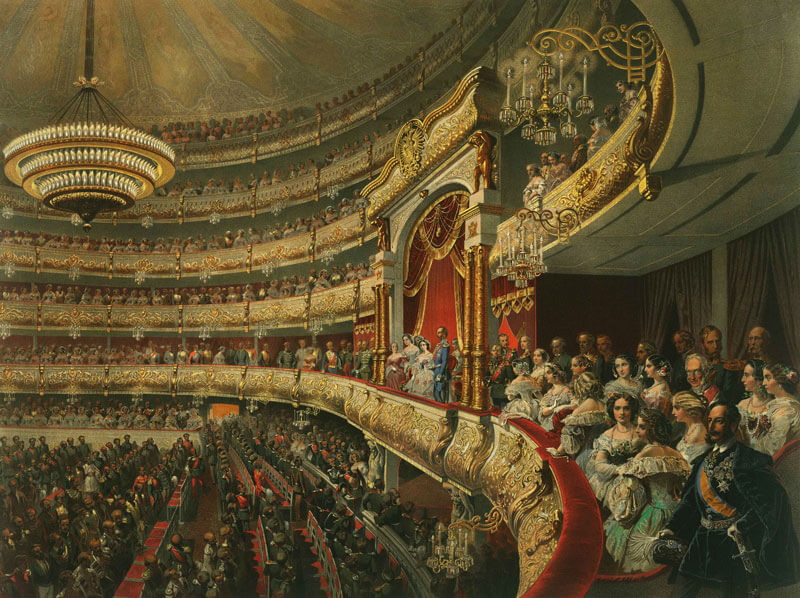
Dance as Writing
What was danced on all these stages? In the mid-sixteenth century, the court composer of Louis XIV, Jean-Baptiste Lully (1632–1687), developed a French style and French-language opera (tragédie en musique or tragédie lyrique), which mingled recitative and sung arias and often included danced segments. In the field of dance, Lully is best known as the creator of the minuet, which later became a popular social dance form. In the arias sung in Lully’s ballets, the roots of early concert music can be surmised, as these could be taken out of their dance context and performed separately. The person mainly responsible for the dances in Lully’s ballets was Pierre Beauchamps (1631–1705), Louis XIV’s dancing master.
The distinction between a dancing master and a choreographer is essential, here, as choreography in the Baroque period primarily meant written dance notation, most of which were social dances. In the seventeenth century, the idea of a work was very different from that of today. There was no point in writing down or reproducing art dance because, even once the art form was professionalised, dancing was primarily about partially improvised execution of rehearsed patterns in an expression of the individual dancer’s virtuosity – not as a work that could be reproduced independent of the time, place or performers. The same performance could also be called a dance, a pantomime, an opera or a play, depending on the context and the particular performers. When the same themes and titles are repeated in the archival sources, it is difficult to understand when a work was seen as a novelty and when it was considered repeating an earlier performance – or even why any of this might have mattered.
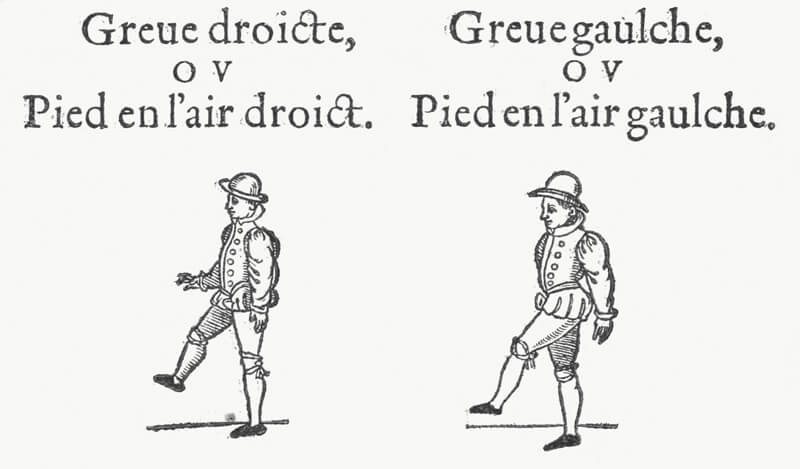
As Jehan Tabourot (1520–1595), writing as Thoinot Arbeau, argued early in his Orchésographie (1589), notation made it possible to analyse and plan a dance, which could then be danced independently of the dancing master.[6] The primary audiences for dance manuals and notations were whoever employed their author and other dance masters, as these publications spread the reputation of their authors and guaranteed them employment opportunities. It should therefore be remembered that the primary readers of dance literature were from the lower nobility and the bourgeoisie – people from social classes whose members needed to be able to publicly demonstrate their sophistication but who could not afford to hire private teachers. Well into the twentieth century, the vast majority of published dance literature and notations were of social dances and their pedagogy – not records of art dance.

The first widely used method of dance notation was Raoul-Auger Feuillet’s (c. 1660–1710) Chorégraphie, published around 1700. This system of describing the movement of the feet on the floor was probably originally devised by the aforementioned Pierre Beauchamps. Beauchamps is also said to have defined the five basic positions of the feet still used in ballet, although the relationship between the hands and feet in Baroque dance was very different from that of ballet as we understand it today.

In England, John Weaver (1673–1760) became fascinated by French dance notations and translated Feuillet’s book into English as early as 1706. Weaver soon renewed the English-language discourse on ballet with the publication of An Essay towards an History of Dancing in1712, and a swathe of other writings on dance technique, dance history, mime and pantomime. In his ballet The Loves of Mars and Venus (1717), he attempted to revive an ancient pantomime based on Lucian’s essay. This ballet is generally regarded as the first to present a narrative using only dance, gesture and music, without the help of narrative speech or song. The main roles were played by Louis Dupré (as Mars), Hester Santlow (as Venus) and Weaver himself (as Vulcan). The work was performed an extraordinary seven times, and new stagings of it were created until 1724.[7]
Across the English Channel, Jean-Philippe Rameau (1683–1764) challenged Lully’s Baroque style in music theory. His namesake Pierre Rameau (1674–1748), the dancing master to Queen Elizabeth of Spain, wrote the Baroque dance manuals Le Maître à Danser (1725) and Abbregé de la Nouvelle Methode (c. 1725). The former used drawings to illustrate the steps, gestures and etiquette of formal ballroom dancing, while the latter contained dance notations from the ballets of Louis-Guillaume Pécour (1653–1729).[8]

The profession of a dancing master usually involved designing and teaching both social and art dance. Well into the twentieth century, many professional dancers supplemented their income by teaching social dances. The ballroom was the social stage of the upper classes, playing an important role in the arrangement of marriages between families.[9]
The idea of re-performing music by dead composers out of a written musical score only emerged in the late 1700s, and classical music as a concept is even more recent.[10] This idea of re-performing spread from music to dance, but even at the turn of the twentieth century, ballet was still characterised by the adaptability of its choreographies, as ballet masters fit their works to the dancers starring in them. It was not until the 1930s that past works began to be thought of as benchmarks for future repertoire – in other words, as classics.[11]
Sallé, Garrick, Noverre and the Stage as a Picture
In the second half of the seventeenth century, civil servants and the bourgeoisie keenly followed the performing arts, as patronage for the arts was a sign of nobility of the mind. Changes in theatre space and audience structure were also directly reflected in the ideals of art dance, where emphasis was increasingly placed on the plot. The staged opera ballet brought new dimensions to dance as machinery lifted dancers into the painted clouds above the stage.
In dance history, the development of ballet from the Baroque to the Enlightenment is associated with Jean-Georges Noverre (1727–1810). In dance, the early eighteenth century was a period for strong women. The themes of ballets began to move away from ancient myths, but essentially the same ballroom dances that the gentry danced at parties outside the theatre still featured prominently on stage. In 1714, Françoise Prévost (c. 1680–1741) created Les Caracteres de la Danse (“The Characters of the Dance”). The “characters” were successive pairs of lovers of different ages and sexes dancing different dances (a bourree, a minuet, a passepied) to music composed by Jean Ferry Rebel. Prévost taught her dances to two of her most famous pupils, Marie Sallé (1707–1756) and Marie-Anne Camargo (1710–1770).
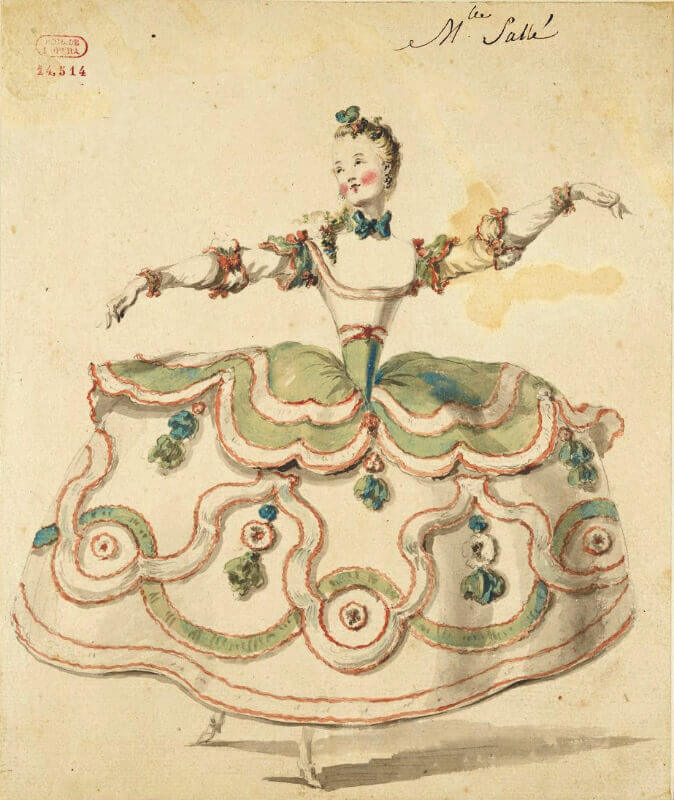
Born in France into a family of acrobats, Marie Sallé began her dancing career in London in 1716 before joining the Paris Opéra. Sallé was a particularly strong actress, able to express the music and convey the story to the audience. She discarded the stage mask and, quite exceptionally, began to create her own choreographies in collaboration with composers: she worked in London from 1733 to 1734 with George-Friedrich Handel and danced in France in several of Jean-Philippe Rameau’s operatic ballets.[12]
Born in Brussels, Marie Camargo had an exceptionally strong dance technique. She was the first female dancer to perform the entrechat quatre and favoured a new type of ballet slipper over the typical heeled shoe. Camargo was not the first dancer to wear a knee-length ballet skirt and leotards, but she made this costume popular – as Judith Chazin-Bennahum has shown, famous ballet dancers also influenced fashion off-stage.[13] Marius Petipa’s 1872 ballet La Camargo is loosely based on the kidnapping of this dancer in 1728.
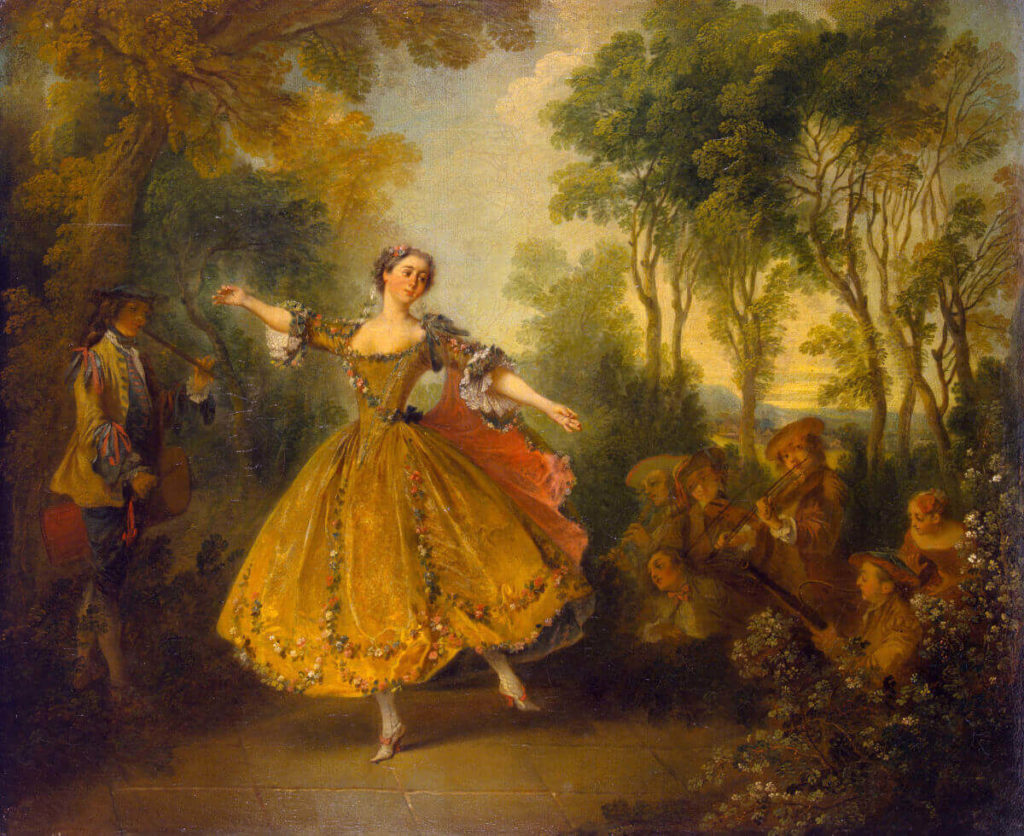
Marie Sallé’s interest in the use of gesture and expression in ballet inspired her most famous pupil, Jean-Georges Noverre, to reflect on the relationship between the stage and the visual arts in his 1752 London work Les Lettres sur la danse et sur les ballets (“Letters on Dance and Ballet”), published in Lyon in 1760. Noverre was working under David Garrick (1717–1779) at the Theatre Royal Drury Lane in London at the time of writing, and Garrick, like Sallé, was interested in the importance of gesture and mime in acting. It is therefore likely that Noverre combined the ideas of his predecessors in his famous book.
In his letters, Noverre particularly criticised the stereotypical, clumsy costumes and sets of the Paris Opéra, as well as the old-fashioned music and choreography. He stressed the dancer’s individuality, personality and style, as well as the importance of sincere gestures appropriate to the content of the drama. He called for a dramatic development in the works that would be logical and direct the whole. In this, he strongly stressed the stage as a kind of moving picture (tableau), which should at each moment be such an aesthetically thought-out whole that, were the movement to stop, the image would still convey the narrative, as in a painting.
Noverre’s name for this style, ballet d’action or action ballet, reflects the importance in the style of plot, drama and action. The key difference between action ballet and its predecessor was in its visual emphasis over the poetic ideal – the idea that, in order to perform passions, a dance must consist of a series of stage pictures that form a stylistically and narratively coherent continuum within the frame of the proscenium. Although ballet d’action sought to stress that ballet could tell stories as complex and varied as those of theatre, its dance aesthetic was based on the contemporary scientific understanding of perception as a series of images. A momentary inaesthetic posture of a dancer could thus ruin the aesthetic of the whole. Noverre stressed that at every moment, dancing had to strive to be like an artist’s finished painting, in which every detail seamlessly served the overall impression.[14]
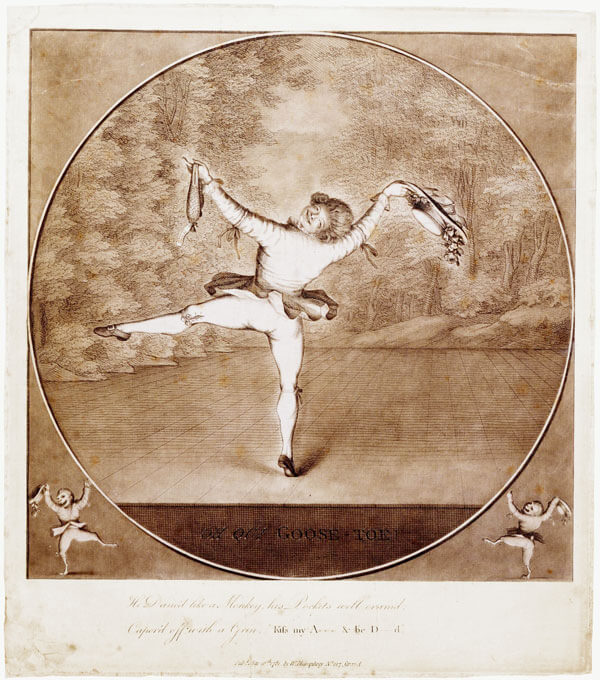
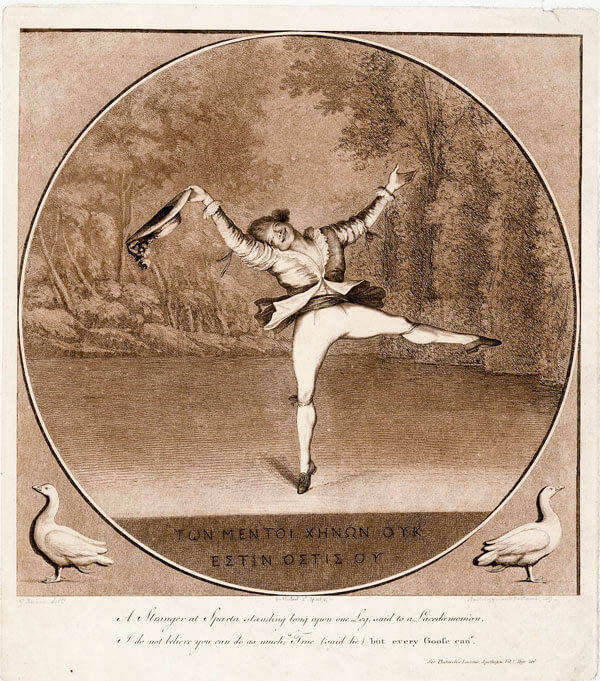
Noverre’s demands have since been interpreted in light of the Gesamtkunstwerk or total work of art ideal of German Romanticism, although Noverre’s text predates these by more than half a century. The misinterpretation of Noverre as an advocate of the total work of art goes back to twentieth century Russia, where the entire history of ballet was rewritten in the image of the empire. But before that, let us delve into the Romantic period, the heyday of ballet as an art form of the bourgeoisie. The nineteenth century is represented as both ballet’s greatest heyday and its worst decline.
The Romantic Age – From Action Ballet to Sensual Impressions
The French Revolution of 1789 and its aftermath meant major changes in the arts. Noverre’s ballet d’action had relied heavily on retelling ancient stories, which were considered timeless and true, a kind of ideal art. In the art theory of Classicism, heroic and tragic roles were reserved for the nobility, moral sermons for the clergy and comic roles for the lower classes. Since tragedy was the prerogative of the nobility, it required a noble sponsor. In times of political upheaval, ancient themes were still safe, as their reinterpretation could always be justified by their “timelessness.” In the late seventeenth century, the nationalism that spread especially among the middle classes and the emerging Romantic style sparked a revolt against the values of Classicism. Local stories and “real people,” more like the audience itself, were wanted on the stage.
The horseshoe auditorium and new technologies of the nineteenth century, such as the steam engine and gas lighting, allowed theatre stages and buildings to grow: steam could power heavier machinery and gas could illuminate a larger space than candles. In large theatres, new acoustics and lighting led to new problems: the proscenium enclosed the sound of both actors speaking their lines and the singing of opera soloists. The footlights did not illuminate deeper into the stage space, but further back, lighting was a fire risk. The performers therefore had to step in front of the proscenium to be heard. Until the mid-nineteenth century, the lighting in the auditorium was not usually lowered during the performance, as the audience also ate, drank and talked throughout.
From the late seventeenth to the end of the nineteenth century, railways and steamships made travel ever easier. Touring and visiting artists were more frequent, spreading the latest inventions and fashionable topics. Dancers and choreographers stole from each other without a second thought, and for many works there is no point in even trying to define an original version simply because the original had no such import in the performing arts as it does today. In ballet, a work was not characterised by an ideal of an unchanging choreography somehow worth preserving. The plot, music, staging and costumes were equally mutable, changing as needed from performance to performance.
The ballet versions of Egidio Duni’s comic opera La Fille mal gardée (“The ill-guarded girl”), first performed in Paris in 1758, may serve as an example of this mutability. In ballet history, La Fille mal gardée is often said to be based on the 1789 choreography by Jean Dauberval (stage name of Jean Bercher, 1742–1806), even if this was first performed as Le ballet de la paille (“Straw ballet”). Dauberval’s choice of subject matter may have been influenced by painting, reflecting the way in which ballet novelties were often adaptations of other arts. Charles-Louis Didelot (1767–1837), who danced the male lead in the 1791 version, took the ballet to Russia, where his version was performed in 1818. Even before this, several versions of the work had been performed to different pieces of music. The versions performed today are based on this Russian tradition, notably choreographies by Marius Petipa (1885) and Aleksandr Gorsky (1903).
Thus, we do not really know whether Didelot was in any way trying to follow Dauberval’s work (let alone the opera that inspired it), or what Petipa or Gorsky might have used from earlier versions in their own choreographies. In the versions performed today, barely anything remains of Didelot’s choreography, let alone Dauberval’s ballet or Duni’s opera. La Fille mal gardée is historically significant because, given the comic nature of the work, its protagonists are bourgeoisie, which appealed to nineteenth-century bourgeois audiences. It is fundamentally incorrect to think of this work as a choreography surviving from the seventeenth century, or even as the oldest ballet choreography performed today.
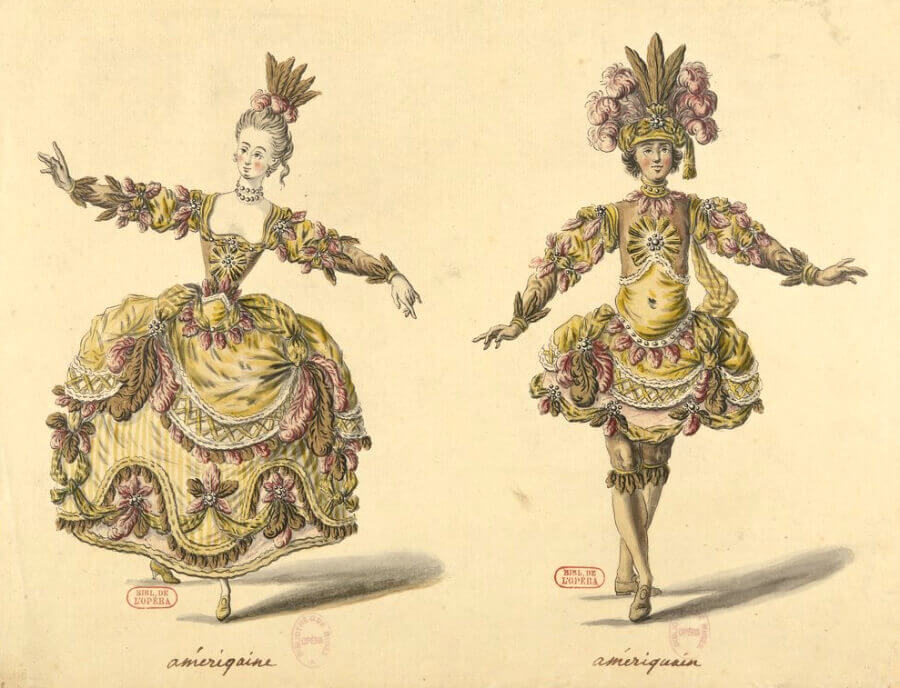
Born in Stockholm, Charles-Louis Didelot was the most prominent student of Dauberval and Noverre. Didelot is known not only as a ballet master but also as the inventor of the pointe shoe. Didelot made great use of new stage technology, and his work Flore et Zéphire (1796 and 1815) delighted his contemporaries with dancers “flying” on wires across the stage and a ballerina rising on her toes with the help of stage machinery. Female dancers soon began to develop en pointe technique independently of stage technology. Three different ways of stepping onto the hardened tip of the shoe emerged: relevé, where the dancer slides onto the tip without lifting the slipper from the floor; sauté, where the dancer jumps onto the tip of the slipper; and piqué, where the dancer steps onto the tip of the stretched-out foot. All of these techniques require a strong ankle and full body alignment from the top of the head to the tip of the slipper to maintain balance and avoid injury.
In 1801, Didelot was offered a position in Russia at the Imperial Theatres, first as a principal dancer and later as a ballet master. This spectacular start to his career unfortunately ended with his dismissal in 1810 after the new ballet master had angered the theatres’ management. Didelot returned in 1816, and was again dismissed in 1830, this time for being too involved in the Decembrist uprising. Didelot’s fate influenced how the ballet masters who succeeded him at the Imperial Theatres generally avoided subjects that might be interpreted as too political.[15]
Elsewhere in Europe, ballet found a new audience among the bourgeoisie, and themes of the works soon reflected this. In the early 1830s, Louis-Désiré Véron (1798–1867) saved the Paris Opéra from bankruptcy by turning the ballet’s back room (the so-called foyer de la danse) into a social venue for wealthy gentlemen. As in other theatrical professions, the dancers’ status as servants of the nobility corresponded to a lower class background. The physicality of dance and the often very revealing costumes tested the boundaries of chastity expected of women in particular. Although professional dancers stressed their respectability, the reality was often quite different: a wealthy admirer bribing a dancer with jewellery could also press the theatre management to grant them more prominent roles, which in turn could lead to a career as a dance teacher or ballet master/mistress. Such arrangements contributed to the frivolous reputation of – particularly female – dancers.[16]
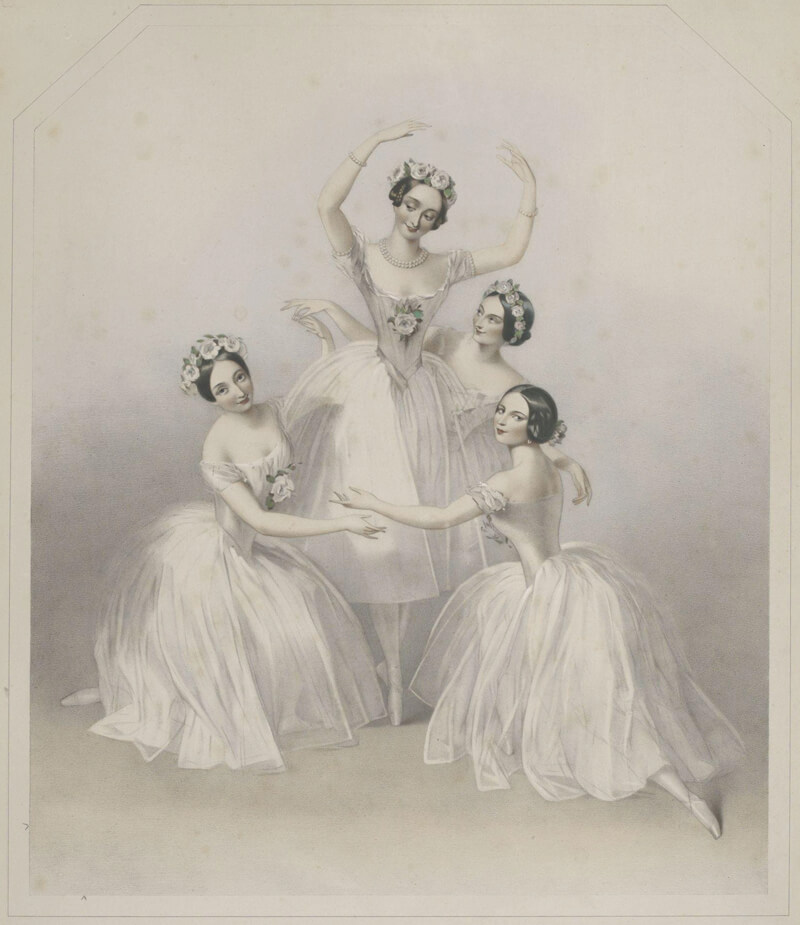
In response to the Enlightenment’s emphasis on reason and logic, Romantic ideals stressed individuality and emotions. An archetype of Romantic ballet is La Sylphide by Filippo Taglioni (1777–1871, music Jean-Madeleine Schneitzhoeffer), whichpremiered in Paris in 1832. La Sylphide is set in Scotland because Sir Walter Scott’s Waverley (1814), Rob Roy (1817) and The Bride of Lammermoor (1819) had established Scotland as a stronghold of Romanticism in the new genre of the historical novel. The story of the young James falling in love with a supernatural, seductive spirit of air (a sylph) instead of his betrothed Effie was a great success: the title role alluded to ancient mythology, but the male lead tied the work as a whole to the locale and a nationality. The man hesitating between a respectable woman accepted by his community and a seductive other was perfectly suited to the male spectators seduced by the foyer de la danse but expected to marry “proper” women of their own social class.
The combination was at once classical, in the sense of respecting traditions, and modern, as a breakthrough in a new style and with the latest in dance technique. Filippo Taglioni designed the piece for the special abilities of his daughter Marie Taglioni. Marie Taglioni was known for dancing on pointe but La Sylphide turned this virtuoso trick into a focal part of the plot. The sylph of the title role is a spirit creature floating gracefully on stage, and her pas de bourrée created an impression of nonhuman movement. Of course, Marie’s unusually short costume of light white fabric meant that the ramp lights shone through it, sexualising the otherwise ethereal spirit. As Lenard Berlanstein has shown, in nineteenth-century France, bourgeois male critics projected themselves as the imaginary lovers of female stars. In the United Kingdom and German-speaking Europe, standards of criticism were very different, and women performers were rarely as sexualised as in France.[17]
During the nineteenth century, very few women could participate in the public discourse around theatre or dance. Writing about dance was a male privilege to the degree that men’s history became the history of the art form. Dance textbooks were written by men on male technique for a supposedly male reader – which is why so little remains of the exercises required to develop pointe technique.For example, Carlo Blasis (1797–1878), who published writings in Italian, French and English on ballet technique (i.e., Traité élémentaire, théorique, et pratique de l’art de la danse 1820 and The Code of Terpsichore 1830), gendered both the teacher and the pupil as male, although it is known that his wife Annunciata Ramaccini (1807–1892) taught the Blasis’ pupils mime.[18]
In his books, Blasis describes in detail the exercises of a ballet class and explains their purpose. His analysis of ballet technique later influenced the teaching methods of Enrico Cecchetti (1850–1928), and through him, Agrippina Vaganova (1879–1951), whose pedagogy has influenced the teaching of ballet in Finland. According to Vaganova, the art of ballet culminates in the structure of the grand pas de deux, andin the Vaganova method, students still have to be able to demonstrate their skills in precisely this kind of a scene between two dancers. The Vaganova method seeks to continuously build on what the dancer has already learned, so that the dancer, in learning a new movement or step, will always find that they already know the elements required to execute it correctly.
Much less is known about the women pedagogues teaching ballet to female dancers before the early twentieth century. Women were subject to social prejudices that restrained them, the worst of which was the belief that intelligence and rationality were exclusively male qualities. As dancers, women’s physicality and emotionality were therefore an advantage, but writing required a very different kind of erudition to which most women had no access. Education was very much gendered, with philosophy and classical literature taught only to men. Publishing texts was extremely difficult even for privileged noblewomen, and became even more difficult in the 19th century: many of the now famous women writers (like the Brontë sisters) originally published their works anonymously or under a male pseudonym. Moreover, the achievements of authors “revealed” to be women were typically belittled or the works alleged to be “really” written by men, because men considered genius to be an exclusively male quality.[19] In addition, legally speaking, most women had no personal wealth, which was commonly required to publish books. Although it is known that the vast majority of dancers and dance masters were literate, they often came from lower social orders, meaning that few had the social connections or economic security required for professional writing.
Since the early nineteenth century, dance had increasingly attracted female artists. Ballet emphasised the expression of emotions, which the new bourgeois order deemed unsuitable for proper men, a remnant of the old order. As the profession was poorly paid, ballet became feminised, with more women than men becoming professional dancers, and women became increasingly responsible for choreography. Contrary to what some dance historians have argued, the male dancer did not disappear from the stage, but became an alter ego to the presumably male spectator (and dance critic) in a casting that highlighted heterosexual and bourgeois values on stage.[20]
In the performing arts, en travestie or cross-dressing to represent the opposite sex, became very popular in the second half of the nineteenth century. However, the practice was governed by strict aesthetic and moral standards. Men dancing skirt roles always performed old or otherwise “ugly” women, while women in trouser roles never played men but always handsome youths or women in disguise. For women, trouser roles offered the opportunity for “masculine” movement, such as series of jumps, and in the nineteenth century almost all famous female dancers performed in some trouser roles during their careers.[21]
Mime vs Dance
Apart from La Sylphide, another Romantic ballet still frequently performed is Giselle (1841), similarly named after the female lead and similarly first performed in France. It was conceived as a vehicle for the Italian ballerina Carlotta Grisi. The choreography was created by Jean Coralli (1779–1854) and Jules Perrot (1810–1892) to a libretto cowritten by the poet Théophile Gautier (1811–1872) and Jules-Henry Vernoy de Saint-Georges (1799–1875), with music by Adolphe Adam (1803–1856). The rural village and the peasant girl Giselle in the first act reflected the medieval pastoral the Romantics adored, with a scandal that suitably titillates the bourgeois audience: the young man that Giselle loves, Albrecht, turns out to be a local nobleman about to marry the noblewoman Bathilde and thus to betray the commoner, much as aristocrats did in the ancien régime. Giselle kills herself, and in the second act has therefore become a wili, a vengeful ghost. However, Giselle relents and saves Albrecht from the death sentence imposed on him by Myrtha, the Queen of the Wilis. For this, Giselle herself is laid to rest in consecrated ground.

When the work was later performed in Russia, with choreography by Marius Petipa (1818–1910), the plot had to be changed. In the theatres of a ruler anointed by the Orthodox Church, the mortal sin of suicide could not be performed on stage, even if this made the plot of the second act nonsensical. Hence, in most contemporary versions of the choreography, Giselle dies from losing her mind or of heartbreak.[22]
As Marian Smith has shown, in the earliest notations of the Russian version of this work (circa 1900), about half of the length of the ballet was narrative mime. In nineteenth-century ballets, gestures told the plot of the dance, while the danced segments spoke of the emotions of the characters. This division is audible in ballet music: the danced parts required a distinct rhythm, while the composer could expand the melodic and harmonic dimensions of the score for the mime sections that created the atmosphere. In actual performance, famous soloists typically performed solos they had rehearsed for other works, which were then either set to music taken from those other works or the music of the work fit to the rhythm of the dancer. The Grand pas classique of Paquita as performed today is a conglomerate of parts from as many as seven different choreographic works.[23]
The careers of dancers typically progressed from physically demanding parts to mime roles, as expressivity was gradually learned over time. In state theatres, this meant that older dancers who had progressed in their careers to principal dancer had to be fitted into the storylines. The most famous example of this fitting resulted in the role of Benno, the prince’s friend, in Marius Petipa’s Sleeping Beauty (1890), who had to lift the ballerina for the first dancer Pavel Gerdt (1844–1917), who played the prince. When the role of the prince was taken by a younger principal dancer, Benno was no longer needed and the character was forgotten. In some recent retellings of the story, however, Benno’s friendship with the prince has been used to highlight the possibility of homosexual love in the narrative. Different interpretations of the “same” work thus allow for a kind of constant updating of specific ballets in terms of what is emphasised in their choreography or in the narrative.
Romanticism brought into fashion the ideal of a total work of art, in which all the elements of the performance formed a harmonious whole. The most vocal advocate of this ideal was the German composer Richard Wagner (1813–1883), who regarded the ballet scenes in operas as facetious and called for their subordination to the plot. Wagner stressed the importance of the vision of a single author in achieving the total work of art, to the extent that he had a new kind of theatre built in Bayreuth for the performances of his own works. Wagner’s profound dislike of ballet and belief that art should represent any contemporary topics had a negative impact on ballet.[24]
The total work of art ideal led to a greater differentiation of dance from other forms of theatre and gradually to seeing dancing as more central to ballet than mime. During the twentieth century, the amount of mime in ballet has steadily declined and choreographies became more about dancing. Paradoxically, this has meant a decrease in the power of the star dancer and an increase in the power of the choreographer: star dancers can no longer decide which solo they would like to dance in a performance.
The difference between music for dancing and music for mimed sequences only began to disappear in the ballet compositions of the early twentieth century. As in the free dance of the time, ballet began to adapt dance to compositions not originally intended for the stage. More diverse music meant that dancers could no longer rely on hearing the rhythm or melodic cues of the orchestra, but had to start counting their steps. This musical approach was a reaction to the extreme emphasis on the visual spectacle and action in the second half of the nineteenth century. In the history of dance, this period of variety theatre ballet has been represented as the greatest decline in the art form and as the time when its greatest masterpieces were created. The contradiction is due to the distortion of dance historiography after the First World War.
The Second Half of the Nineteenth Century – Towards an Increasingly Spectacular Spectacle
It was only towards the very end of the nineteenth century that the ballet master became a choreographer in the sense that we associate with the term today. Authorship meant a share in the work’s profits, and from the 1830s onwards, this usually required membership in an organisation protecting the rights of authors and a written notation. In order to receive a share of the box office income in addition to their salary, a ballet master or mistress had to show that they had done more than simply arranged (régler)themusic or libretto for the stage.[25]
In the early 1890s, the choreographers’ importance was promoted in particular by Madame Mariquita (1838–1922). After a rather mediocre career as a dancer, she became a ballet mistress in Parisian variety theatres. Born in Algiers, possibly as a daughter of a French colonial official, Mariquita advertised herself as an Italian ballerina. In a career that lasted from the mid-1880s to 1920 she was the ballet mistress at the Théâtre de la Gaîté, the Folies Bergère and the Opéra Comique, choreographing more than 300 works from short divertissement numbers to evening-long spectacles. In 1900, Mariquita was also responsible for the pavilion dedicated to dance at the Paris World Fair, the Exposition Universelle. Little is known for certain about her career, which lasted for more than 70 years, as she was obviously quite creative in narrating her own life. She was apparently the first choreographer to secure copyright for her choreographies through the Société des Auteurs et Compositeurs Dramatiques in the 1890s, by demonstrating that she indeed created (créer) her works. Thanks to her good public relations, she also succeeded in getting dance critics to emphasise her part in the creative process. Mariquita also taught a whole generation of dancers, although the most famous of these are known primarily as courtesans: Liane de Pougy (1869–1950), Émilienne d’Alençon (1869–1946), Régina Badet (1879–1949) and La Belle Otero (Agustina del Carmen Otero Iglesias, 1868–1965) were all Mariquita’s students.[26]
The most prominent choreographer in late nineteenth-century London was the Austrian Katharina Josefa “Katti” Lanner (1829–1908). Her father had been a composer specialising in dance music and a rival of Johann Strauss the Elder. Lanner began her dancing career quite young at the Vienna Court Opera (Hofoper). She performed with the famous stars of her time, Fanny Elssler (1810–1884) and Marie Taglioni, and both Paul Taglioni (1800–1884?) and Auguste Bournonville (1805–1879) created works for her. In 1865, Lanner formed her own touring company and performed for a decade all over Europe and in the United States before taking up a position as a teacher at the Theatre Royal Drury Lane in London. When the Empire Theatre opened in Leicester Square in 1887, Lanner was hired as its ballet mistress. Over the next twenty years, she choreographed at least 34 ballets for the theatre and worked closely with Adeline Genée (1878–1970), the best known Danish-born ballerina of the early twentieth century. Lanner’s 1889 choreography about the Exposition Universelle in Paris that year illustrates how ballet kept track of current trends.[27]
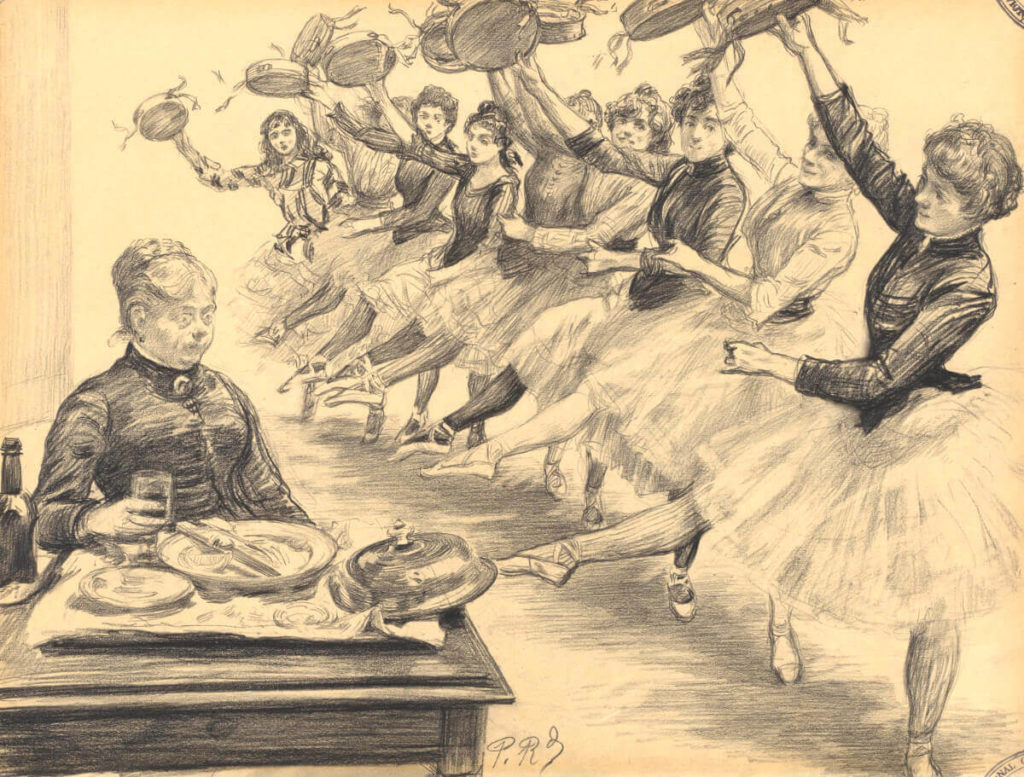
Famous dancers of the second half of the nineteenth century include the “Divine” Virginia Zucchi (1849–1933) and Enrico Cecchetti, later known as a pedagogue, who danced the first Blue Bird role in Marius Petipa’s Sleeping Beauty. As the art form became more and more widespread, it also became increasingly difficult for ballet dancers to achieve status above others and true stardom. The emphasis on virtuosity meant raising one’s legs ever higher, more turns and longer and higher leaps. The nineteenth century was also a period of development in ballet pedagogy, driven not only by scientific interest in the human body and its movement, but also by the need for pedagogues to standardise what they taught. Yet even within the same state or institution, very different styles of teaching could coexist, allowing dancers to specialise in certain kinds of roles.[28]
In the 1880s, electricity came to metropolitan theatres, revolutionising both lighting and stage technology. Electric light was remarkably bright and much safer than open fire or natural gas. Electric motors replaced horses, steam and humans in powering stage machinery. Ballet became particularly popular in the large-scale variety theatres, where stage technology allowed for ideas that to us today sound truly wild. The most important new genres of the second half of the nineteenth century were the grand ballet and the féerie (fairytale ballet). In late nineteenth-century parlance, grand ballet, which originally had connoted the grand finales of court ballets, came to mean any kind of full-length ballet in which dance numbers with stage effects were united around an often very loose theme or plot. Féerie, on the other hand, developed from the Romantic themes of the early nineteenth century, with focal elements from fairytales or the supernatural.
Choreographed by the Italian Luigi Manzotti (1835–1905), Excelsior (1881) was an extreme example of a grand ballet. It celebrated new technological inventions including the steamship, the voltaic pile (electric battery), Edison’s light bulb, and the Suez Canal. The almost plotless work toured Europe and was even made into a film version in 1913. Despite its great popularity, this kind of topical ballet soon dated, and few such works have survived in ballet repertoires.
Conversely, many of the ballets performed as classics of the art form today are féerie ballets. Perhaps the most iconic of these is Swan Lake, originallychoreographed by Julius Reisinger (1828 –1893) for the ballet company of the Moscow Bolshoi Theatre in 1877 to a score by Pyotr Tchaikovsky (1840–1893), but known as a choreography by Marius Petipa that premiered in 1895. The work is typical féerie in that it is set in a romanticised and magical fairytale world, but unlike many féerie, it has a tragic ending.
Swan Lake: the most iconic féerie ballet
The protagonist of Swan Lake is Prince Siegfried. At the beginning, he is agonising over the need to marry and goes hunting for swans with his friend Benno. The prince is separated from his friends and is stalking a swan with his bow when he sees it transform into a beautiful woman. She is Odette, cursed by the wizard Rothbart to remain a swan until someone swears to love her forever. When Rothbart suddenly appears, Odette stops Siegfried from killing the wizard, because then she would never be free of his curse. When Siegfried next arranges a ball to decide whom to marry, he mistakes Rothbart’s daughter Odile for Odette. Benno sees through Rothbart’s spell and tries to warn his friend, but Siegfried vows to marry Odile. Rothbart reveals his demonic appearance, and Siegfried sees the real Odette flashing in the window. He races after her. In the final scene, Odette meets the prince once more by the enchanted pond. Siegfried begs her forgiveness and tries to force her to stay with him by throwing her crown into the pond. Odette dies in Siegfried’s arms.
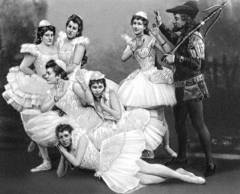
There are several variations on the Swan Lake plot, and there are three- and four-act versions of the ballet, some of which explain how Odette came to be cursed by Rothbart. In some versions of the work both lovers die, or Siegfried dies in battle with Rothbart, or the curse is broken and Siegfried and Odette are reunited. In 1995, the British choreographer Matthew Bourne changed the gender of the swans to male, in order to shift the narrative into a story about the prince’s homosexuality and the negative attitudes of society. This version can be seen in the final scene of the film Billy Elliot (2000). Swan Lake has thus expanded in an extraordinary number of directions. Just as the work referred to earlier fairytales about swan princes and princesses, it has become a cultural referent of its own, its music a recognisable ballet “hit” both in dance and on figure skating arenas. Today, the pas-de-quatre of theLittle Swans is also often performed as a separate piece.
Large-scale productions like Swan Lake were expensive to create, so it was desirable that they remained in the repertoire for longer periods of time and circulated to other theatres. Along with the theatrical press, touring was the basis of the reputation of all the great stars of the nineteenth century, as ballet’s broadening audience constantly wanted something new and wonderful to watch. When Imre (1845–1919) and Bolossy Kiralfy (1848–1932) adapted Jules Verne’s novel Around the World in 80 Days (1872) for ballet in Paris in 1874, the work was seen in New York very soon, in the autumn of 1875. Kiralfy’s career illustrates the ways in which ballet, like other arts, was harnessed in the service of tourism, nationalism and imperialism. Imre Kiralfy went on to work for P.T. Barnum’s circus, producing the spectacle Columbus and the Discovery of America for Madison Square Garden in 1892 and America for the Chicago World’s Fair the following year.[29]

Ever since the days of ballet d’action, ballet had adopted the gestures from the theatre, where the correct physical expression of rhetoric was fiercely debated between different schools throughout the century. Everything performed as ballet did not rely on ballet technique, but the word “ballet” became a generic term for dance performed on stage: for example, Boosra Mahin’s khon dance company was headlined in 1900 as the Royal Ballet of Siam. As in other theatres, large spectacles often used extras hired on the day of the performance – soldiers who were used to marching in formation were particularly favoured for these parts.
In the nineteenth century, a ballet could be anything from a short dance number by a single dancer to a mass spectacle with hundreds of performers. Ballet encompassed everything from virtuosic solos to complex, plot-driven works in several acts. Ballet was performed both in state theatres and in travelling circuses, as full-length dance spectacles, as part of operas and operettas, and as short numbers between other acts. Longer pieces could have plots satirising bourgeois marriage markets or current events, turning ancient tragedies into dances or narrating about exotic lands. From contemporary accounts, it is possible to deduct that spectacular and special effects were emphasised when dancers flew to the moon suspended on wires (Le voyage dans la Lune, chor. Henri Justamant [1815–1864], Paris 1875) or escaped from temples collapsing in an earthquake (La Bayadère, chor. Marius Petipa, St Petersburg 1877), as if in the action films of today. The Spanish dancer Carmencita (Carmen Dauset Moreno 1868–1910), who appeared both at the Exposition Universelle in Paris in 1889 and in Bolossy Kiralfy’s ballet Antiope the same year, was also possibly the first dancer to appear in a commercial film, in 1894. As film technology developed, dancers found their way into the moving pictures and film choreography became a new aspect of the expanding field of dance.
New technologies influenced the aesthetics of dance, the ways of viewing and consuming dance, and the self-organisation of dance as an art form. However, the canon of art dance does not reflect the significance given to works in their own time, nor does popularity or longevity in circulation in different countries guarantee a continuing reputation in the new century. Like the grand opéra genre in opera, most of these late nineteenth-century ballets have been completely forgotten. The names of the ballet masters and mistresses responsible for them are not known in dance history textbooks, and their star dancers are presented as the lowest form of ballet. The reason for this can be found in Russia.
The ‘Old’ and the ‘New’ Ballet in Russia
After the French Revolution, autocracy came to an end as one by one, European monarchies moved towards parliamentarianism. The last bastion of autocracy in Europe was Russia, where even after the 1905 Revolution, the Emperor still clung to his right to dissolve the State Duma (the lower house of the parliament). In Russia, ballet was primarily an art form of the court: its budget was practically inexhaustible thanks to the support of the monarch. It is telling that ballet flourished in Russia during an era of political repression and restrictions on freedom of opinion, particularly during the reign of Alexander III (1881–1894). The Imperial Theatres held a monopoly in St Petersburg (the new capital) and Moscow (the old capital) until 1882, but as ballet had no spoken lines, it could circumvent censorship more easily than drama or opera, and ballet was performed in various variety theatres, people’s houses, and circuses. These popular theatres attracted the greatest international star dancers of the time to Russia.
Although Russian ballet is almost entirely associated with the Imperial Theatres, all the major cities of the Empire had ballet schools and permanent dance companies – most notably the Teatr Wielki (Grand Theatre) in Warsaw. However, although the Imperial Theatres employed dancers primarily from their own schools, their choreographies were created mainly by French ballet masters: Jules Perrot, Arthur Saint-Léon and Marius Petipa shaped the tradition of Russian ballet on which our idea of classical ballet still largely relies. The themes of these ballets were typically escapist: the majority were either féeries or exotic ballets with supernatural elements. The most famous of Saint-Léon’s works, Coppélia, is the story of a mechanical doll created by Dr Coppelius, who is so much like a living person that the young man in the village, Franz, falls in love with the doll instead of his fiancée, Swanilda (if the plot sounds familiar, compare it to La Sylphide).
As the majority of performances at the Imperial Theatres were for season ticket holders, Marius Petipa considered the principal duty of a ballet master to be constantly updating the dances on stage, highlighting the particular strengths of each star dancer and incorporating the latest special effects. Russian dance critics judged the merits of each new cast, and balletomanes also championed their favourites in the press. As the new century dawned, some of Petipa’s colleagues began to consider the advantages of preserving the art of dance: Vladimir Stepanov, interested in movement analysis, created a dance notation based on music, which Aleksandr Gorsky, later promoted to ballet master of the Bolshoi Theatre in Moscow, taught to the dancers of the ballet school. Gorsky also used the notation system to transfer Petipa’s choreographies from the St Petersburg company to Moscow.
Dance notation emphasised the movement of the body even in the mimed parts. It also represented the choreography as an entity that was not to be changed from one performance to the next. Petipa considered notation to be an unnecessary flight of fancy, but thanks to notations of his works we have a better idea of what a choreography might have been like at a particular point in time. Generally speaking, there were many more dancers in Petipa’s works, the movement language was simpler and, in Sleeping Beauty, for example, many of the features considered essential to the work turn out to be later additions.[30]
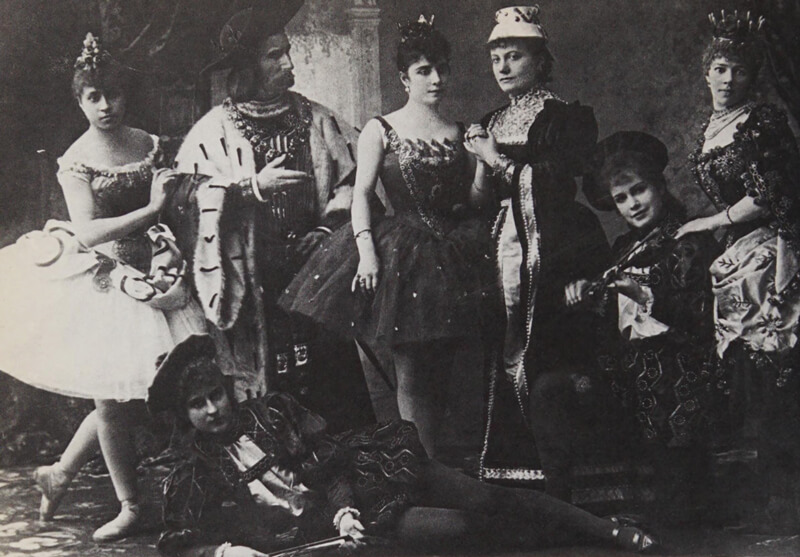
Mathilde Kschessinska: the career of a prima ballerina assoluta
As elsewhere in Europe, dancers tended to come from lower social classes or from theatrical families, but a contract with the Imperial Theatres guaranteed not only a better-than-average salary but a pension. Even the most popular star dancers did not earn as much as the stars of the opera or theatre, but social capital was often more important than salary: Mathilde Kschessinska, the daughter of a court musician who was the mistress of the future Emperor Nicholas II in her youth and then (simultaneously!) the mistress of two Grand Dukes, certainly did not pay for her jewels and palace from her salary. The favour of the ruling family gave Kschessinska the power to determine not only her own career but that of others, to the extent that it was rumoured that she had caused the dismissal of the Director of the Imperial Theatres, Prince Sergei Volkonsky. Conversely, the ballerina Tamara Karsavina recalled Kschessinska’s support for her own career, as she had taught her about “forks,” or the complex etiquette of the court. After two revolutions and a world war, Mathilda eventually married Grand Duke Andrei after they both lost most of their fortunes, and the prima ballerina assoluta, who lived to be 98, supported her family by teaching ballet in Paris.
At the turn of the century, winds of change were blowing in the ballet of the Imperial Theatres. While in Moscow, Aleksandr Gorsky had met Vladimir Nemirovich-Danchenko and Konstantin Stanislavsky, directors of the Moscow Art Theatre. The Moscow Art Theatre was a private theatre whose realistic style owed much to the German Meiningen group of the late nineteenth century. The theatre had become famous in 1898 for its performances of Anton Chekhov’s play The Seagull: the play had previously been poorly received in St Petersburg, but the Moscow group’s intimate, naturalistic performance style and ensemble work made both the play and the troupe famous.
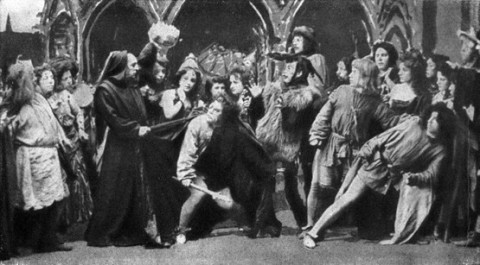
Gorsky was fascinated by psychological realism and wondered if it could work in ballet, where Noverre’s idea of ballet as a tableau had been overshadowed by spectacle and the bravura of star performers. Gorsky challenged how dancers were commonly placed on stage: the role of the chorus as a living scenery framing the main performers, the choreographic lines based on geometric ideal forms, and the disregard for a purported historical period or culture in the staging and costuming of the work, where the ballerina danced in a tutu whether in ancient Egypt or as a seventeenth-century French princess.
Gorsky’s good relations with Vladimir Telyakovsky, the Director of first the Moscow company and then of all the Imperial Theatres, enabled him to try out his ideas in first small-scale experiments and later in full-length works. Gorsky quickly became very popular with the corps de ballet, as the style quickly named “new ballet” emphasised the ensemble and allowed corps-de-ballet dancers to express their individuality. During the 1905 Revolution, Telyakovsky decided to replace the ageing Marius Petipa as ballet master of the Mariinsky Theatre in St Petersburg with Gorsky. The ballet dancers refused these reforms and, inspired by the general strike, went on strike until Petipa and his assistants were reinstated. Gorsky continued as the ballet master of the Bolshoi Theatre in Moscow, but his ballet Don Quixote convinced at least one of the strikers, Mikhail Fokine, of the appeal of the new ballet.
Of course, the term “new ballet” meant that the mainstream represented by Petipa became known as “old ballet”, and ballet critics began to argue about the pros and cons of the new and the old. Proponents of the new ballet stressed the success of realism in theatre, the importance of scenography and the idea of the total work of art; advocates of the old ballet stressed the importance of dance technique, the timelessness of Classicism and independence from the vagaries of fashion. Yet the greatest import of the new ballet would lie outside of Russia and even of ballet itself.
The Russian Ballet of Diaghilev (and a Few Others)
At the beginning of the twentieth century, the most famous ambassador of Russian ballet was Anna Pavlova (1881–1931), a ballerina of worldwide renown. Pavlova specialised in short solos, the first and most famous of which was The Dying Swan, choreographed for her by Mikhail Fokine in 1907 to music by Camille Saint-Saëns. Pavlova first left Russia with a group directed by Edvard Fazer, but soon began to consolidate her fame particularly in the United Kingdom. In 1910, she formed her own company and began performing in places where ballet was not typically seen. Pavlova danced in the United States almost every year from 1912 to 1926, touring Canada and Mexico, South America, India and even Australia. She appeared in films and magazine advertisements and even had a meringue dessert named after her.
At the end of the annual theatre season in May–June 1909, Paris was buzzing with excitement regarding a visit of the Imperial Theatres of St Petersburg and Moscow. Alongside Pavlova, among the dancers was the young Vaslav Nijinsky (1889?–1950), a male dancer who was said to be able to leap higher than anyone else. The visit was a major achievement for Sergei Diaghilev (1872–1929), a Russian impresario who had previously exported fine arts and opera. Diaghilev’s interest in ballet may have stemmed from his intimate relationship with Nijinsky, but he loved opera and music, and his circle included artists from the magazine Mir iskusstva (“World of Art”) that Diaghilev had edited. Of the artists in this group, Aleksandr Benois, Léon Bakst (Lev Rozenberg), Konstantin Korovin, Nikolai Roerich (Rerih) and Sergei Sudeikin had long been interested in the performing arts and stage and costume design.
Diaghilev, who worked at the Ministry of Court, came from an aristocratic family that had lost their fortune and who had been members of the merchant estate only a few generations ago. Diaghilev was therefore well connected to both the nobility and the wealthy merchants, and he certainly knew how to spend other people’s money as if it were his own. Despite popular success, his first attempt at becoming a ballet impresario ended in bankruptcy. After his second attempt, in 1910, Diaghilev not only fell out with the management of the Imperial Theatres but also founded his own private touring ballet company, which he directed until his death.
The Ballets Russes, Diaghilev’s Russian ballet, became a watershed in the history of the art form: two decades of touring took the company to three continents and made ballet an art form that brought together other arts. Diaghilev recruited composers and artists to work in ballet, thus raising the art form’s profile with an audience that had previously shown little interest in dance. At the same time, Diaghilev’s coterie rewrote the history of the art form. In two decades, the company only had one female choreographer, Bronislava Nijinska (1891–1972), and Diaghilev elevated the male dancer in the company’s public image.
Diaghilev’s troupe is usually represented as radical reformers of dance, but in reality, the Ballets Russes relied more on tried and tested themes and working methods. Dancing was usually the last in the order of importance of any novelty, as both Diaghilev and his supporters were more interested in music and fine arts. Before the First World War, Diaghilev commissioned several premieres from both the artists of the Mir iskusstva group and the famous concert music composers of the time: Claude Debussy composed the only ballet score he ever completed (Jeux, “Games,” 1913) for Diaghilev, while Maurice Ravel and Richard Strauss, as well as Diaghilev’s greatest discovery, Igor Stravinsky, made ballet composition a veritable fashion. After the war, Diaghilev also began to attract non-Russian artists, from Pablo Picasso to Marie Laurencin and José Maria Sert to Giorgio de Chirico and Joan Miró.
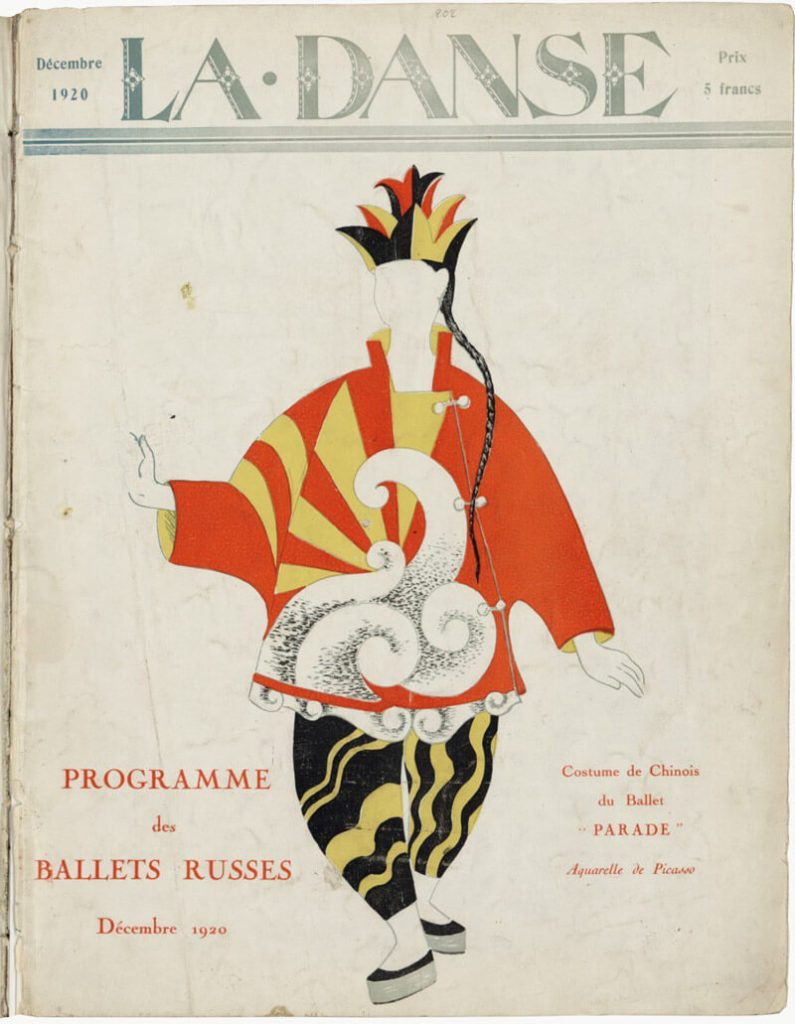
Within Russia – and later in the Soviet Union – the Ballets Russes was associated with variety theatres because, like other touring ballet companies, it performed short works in triple bills. The company was criticised for being tacky and commercial. The short works had no time for character or plot development, and the emphasis on premieres required producing many new works for each season. The same ideas about distant times and exotic places quickly began to recur in the company’s works, the performances becoming increasingly stereotypical.[31]
For Russian critics, the emphasis on acting in the new ballet endangered the reputation of ballet as an art, as it reduced the importance of dance technique, especially in short pieces: in the works of Diaghilev’s primary prewar choreographer, Mikhail Fokine (1880–1942), a principal part could be played by an actor without any ballet training. Although Vaslav Nijinsky’s choreographies (The Rite of Spring) also proved that modernism was possible in ballet, Nijinsky’s approach was not appreciated by Diaghilev’s financiers, which led to a rift between Diaghilev and Nijinsky. After the First World War, the troupe, increasingly associated with its impresario Diaghilev, returned more strongly to visual-narrative ballets with the choreographies of Léonide Massine (Leonid Miasin, 1896–1979). In the 1920s, however, Diaghilev’s troupe was central to the emergence of neoclassical ballet. In the 1930s, the company’s repertoire of short versions of old ballet favourites such as Swan Lake reinforced the narrative of Diaghilev as the man who saved ballet from its decline in the nineteenth century.
Avant-garde and Neoclassicism – Ballet as Manifestation of Music
In the Russian new ballet it is possible to see the beginning of an aesthetic change from visual to an increasingly musical conception of the work. In Romantic ballet, music was linked to emotional expression in the advancement of the story – the most musically interesting parts of the works were the mime scenes. In the short ballets favoured by Diaghilev, the division between dance and mime was broken down, and emotion and drama were more central than in full-length ballets with long danced sequences. The turmoil of the First World War and the Russian Revolution affected values in art. In the 1930s, the nineteenth-century ballet style that had emphasised plots and stage images was renamed classical ballet, in contrast to the modern or neoclassical ballet of the twentieth century.[32] Consequently, the word “classical” came to signify danced expression above all else.
Neoclassicism emerged from a confluence of the new modernist understanding of art and the social upheaval caused by the First World War. In France, the arts turned from prewar reformism of the vanguard modernism towards Antiquity, and in the 1920s various inventive combinations of modernism and neoclassicism supplanted the prewar styles. In the United Kingdom, ballet retained its prewar status, which was only reinforced by Russian visits. Because Germany had lost the war, its empire replaced by a republic, interest in body culture became associated with the fears and anxiety around the lost war. Expressionism, including a new free dance movement, Ausdruckstanz, took over and the surrounding discourse often associated ballet with the undemocratic old regime.
In the Paris of the early 1920s, the Ballets Suèdois (Swedish ballet) company directed by Rolf de Maré (1888–1964) came to compete for critical attention with the increasingly less Russian ballet company of Diaghilev. Jean Börlin (1893–1930), the company’s principal choreographer, combined acrobatics, circus and film in ballets whose stories, music, costumes and sets were often created by young celebrities from the Montparnasse: Jean Cocteau, Paul Claudel, Georges Auric, Darius Milhaud, Francis Poulenc, Fernand Léger, Giorgio de Chirico and Francis Picabia.
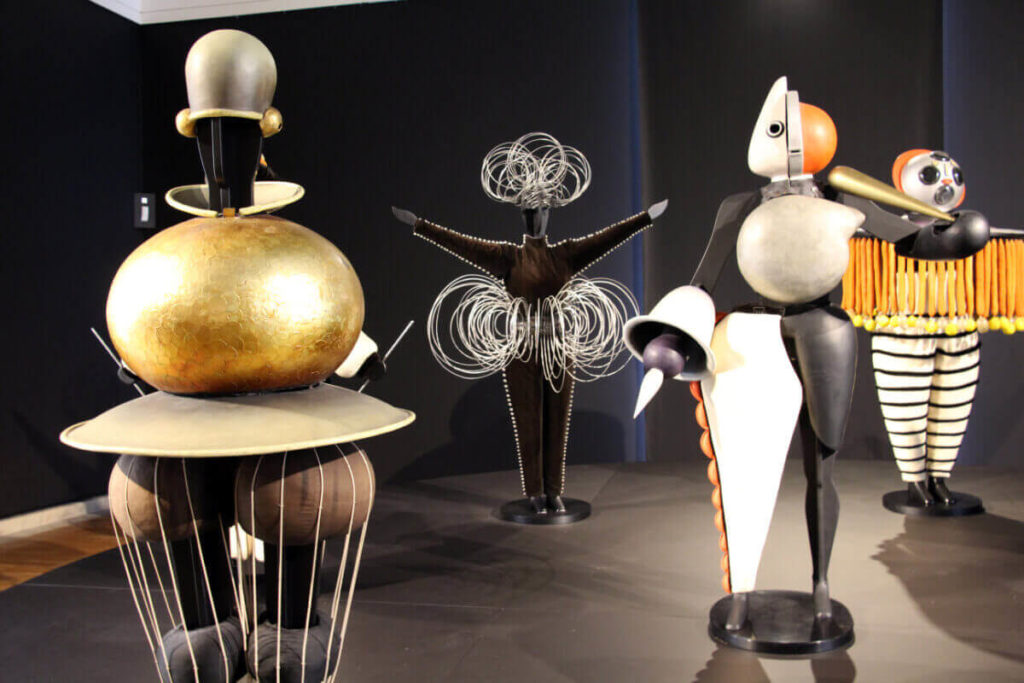
Oskar Schlemmer (1888–1943), who later took part in the Bauhaus group, created his Triadisches Ballett (Triadic Ballet) in the 1910s. This work was inspired by marionettes, and the dancers’ costumes were constructions based on geometric ideal forms. The six movements seek to create a synaesthetic synergy of colour and mood. The work, which premiered in 1922 and was performed only a few times, became a popular example of the influence that the avant-garde in the fine arts had on dance, and the costumes designed by Schlemmer were circulated in art exhibitions. Like Picasso’s designs for Léonide Massine’s Parade (1917) or Naum Gabo’s acrylic costumes for George Balanchine’s (Georgi Balanchivadze, 1904–1983) La Chatte (“The Cat,” 1927), dance remained secondary in Schlemmer’s work. As the Ballets Suèdois also showed, the experimentalism of famous artists did not guarantee that the dance works would be popular with the public or have any longevity in the repertoire.
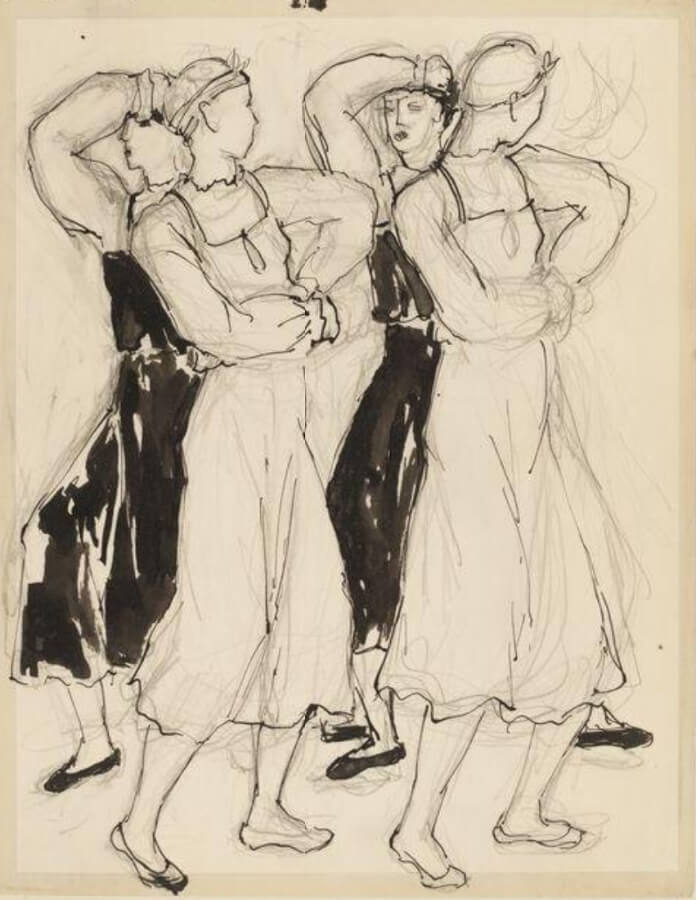
Compared to these, Bronislava Nijinska’s Les Noces (“The Wedding,” 1923), to Stravinsky’s music, represented a very different kind of modernism. The work depicted a Russian peasant wedding, and has often been called proto-feminist. The sets and costumes, which resemble dancers’ rehearsal dress, emphasise Nijinska’s minimalist choreography with its groups of expressionless dancers. The work has often been compared to Nijinsky’s The Rite of Spring, in which Nijinska was originally supposed to dance the role of the Chosen Maiden. The way in which Les Noces combined the traditions of Russian ballet later became central to a style of ballet known as neoclassicism, which is associated with the name of another choreographer of the Diaghilev troupe, George Balanchine.
The paradox of neoclassicism is that it developed when what the Russians had called “old ballet” began to be called “classical ballet.”[33] In a way, neoclassicism took from these late nineteenth-century predecessors only the scenes of dancing for the sake of dancing. A key referent here is the dream sequences in Petipa’s fairytale ballets, which the critic Andrei Levinson, who had emigrated to France, called “white ballet” (ballet blanc). Neoclassicism thus set itself against the dramatic spectacles of the early twentieth century, but, like this style, broke with the old ballet values of strict symmetry and lines of the body.
In line with the formalist (form-oriented) art theory of the time, the expressivity of dance relied on dancing alone, without the need for costumes, sets or plot. Art dance expressed a musical ideal reality instead of a written text or a stage picture. Like the modern dance of the period, ballet moved from the ideals of a total work of art to an ideal of abstraction called choreography: costumes and decor were simplified, the movements of individuals and groups were emphasised over character-driven plots, and instead of the “danceable” pieces commissioned for ballets, choreographic expression was accompanied by music familiar from concert halls.
Although many dance critics praised abstract, completely plotless ballet as the finest expression of modernism, even the key choreographers of neoclassicism did not stick to abstraction alone. Rather, absence of plot remained just one of the many stylistic options of the art form. Elevating music as the new ideal for dance did not go without a hitch. Léonide Massine’s Les Présages (1933) to Tchaikovsky’s Fifth Symphony caused the most orthodox music critics to rage at the misuse of concert music. George Balanchine’s Serenade (1934) was much more favourably received, perhaps because it was performed in the United States, where ballet was not the national treasure it was in France.
The Many Styles of the Twentieth Century
The coexistence of ballet styles in the twentieth century was influenced not only by the diversification of dance, but also by world politics. In the Soviet Union, communism strove for its new worldview through the arts, but ballet survived the upheaval by allying itself with the new power: the People’s Commissar Anatoly Lunacharsky defined ballet Soviet art through emphasising the social class of the dancers. On the ruins of the Imperial ballet companies, the new Soviet ballet was erected, in which the plots, aesthetics and performers were subordinated to the new ideology. The history of ballet was rewritten according to the communist doctrine, the role of Russian artists was emphasised at the expense of the internationalism of the Imperial era and of the former Imperial institutions, and the Bolshoi Theatre in the new capital Moscow replaced the Mariinsky of St Petersburg as the leading company of the art form.[34]
After Joseph Stalin seized power in the late 1920s, the political climate changed. During Stalin’s terror, no-one was safe from persecution, and the dictator blackmailed even his inner circle through those close to them. The revolutionary reorganisation of the theatres, aimed at collective decision-making and the dismantling of Imperial hierarchies, became a travesty: party-appointed politruks monitored the content and casting of new works, various systems of favouritism and competition for the favour of leadership eroded faith in the community, and the ethnic background of the artists began to influence their career prospects. Artists were kept in check by allowing them special privileges, while a climate of spying and backstabbing emerged in the theatres.
As with Louis XIV of France or Alexander III of Russia, the Soviet ballet told the tale of the state rulers. The highest honour of the state bearing the name of Stalin was repeatedly awarded to dancers and choreographers – Stalin’s favourite ballerina Olga Lepeshinskaya (1916–2008) received the prize four times. Such visibility brought danger: Lepeshinskaya’s husband, who was a general in the security police, was arrested twice on Stalin’s orders. Stalin loved the ballet, and the ballet became a showcase of the party leadership to the extent that who attended allowed Western intelligence organisations to make deductions about who was currently in the dictator’s good graces.
The Soviet ballet emphasised virtuosic movement, narrative and loyalty to the party. The official aesthetic doctrine, socialist realism, made abstract dance, or dance for the sake of dancing, a suspiciously bourgeois influence. The heroes of new works were the workers and revolutionaries: the gladiator Spartacus, who led a slave revolt in ancient Rome (Spartacus, chor. Yakobson 1956, Moiseyev 1958, Grigorovich 1968), or the captain of a Soviet ship who helped the rebellious indentured workers of a Chinese harbour and a beautiful Chinese maiden impressed by his good-heartedness (The Red Poppy, chor. Lashilin and Tikhomirov 1927, Lavrovski 1949, Tikhomirov and Kurilko 1957). The Soviet Union actively exported ballet to other communist countries and brought the best dancers from these countries to dance in the Moscow and Leningrad companies.
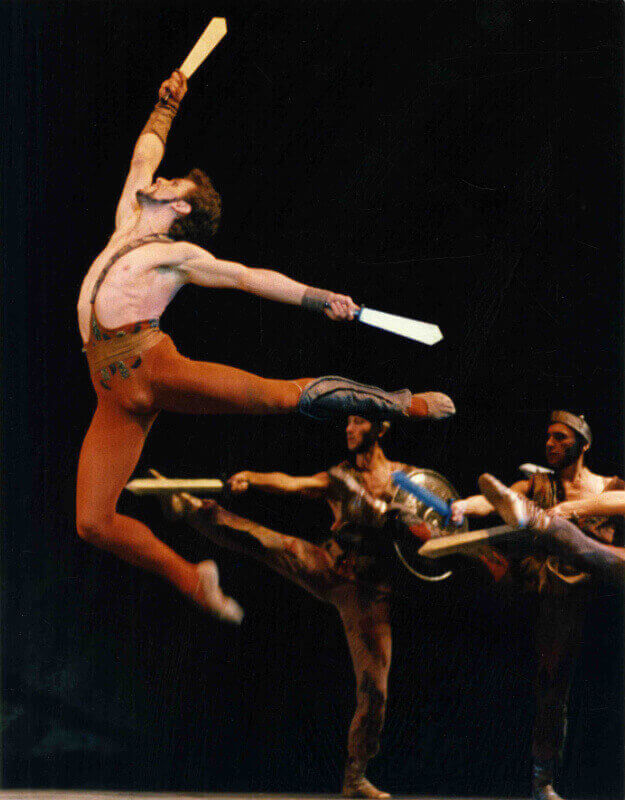
In 1936, choreographer Igor Moiseyev (1906–2007) was appointed as the head of a new ballet company specialising in character dances. Moiseyev’s way of staging folk dances had a major impact on how they were danced in the Soviet Union and its allied or satellite states, and some of the choreographies he created even became popular as folk dances.
The birth of the Soviet Union drove many supporters of the old regime into exile. From the 1920s onwards, ballet was taught in Europe and the United States by numerous Russian emigrants. Its values suited those of the conservative middle class, especially regarding the body culture of young women, and ballet quickly became a popular hobby. “Emigré Russian ballet teacher” even became an early stereotype in Hollywood films. The popularity of the hobby was reflected in the growth of professional companies and schools, and in the new mass media – film and television – ballet became something mundane.
In the 1930s, the legacies of Pavlova and Diaghilev spread far and wide, from the United States to Australia and from Argentina to Sweden. Various companies calling themselves Ballets Russes had emerged during Diaghilev’s lifetime, but the dancers who earned their stripes with him played important roles both as reformers of existing institutions and as founders of many of the more prominent new ballet companies. René Blum, director of the Monte Carlo Theatre, founded the Ballets Russes de Monte Carlo with Colonel Vassily de Basil. After the men quarrelled, the company split into the Original Ballet Russe and the Ballet Russe de Monte Carlo, both of which emphasised their connection to Diaghilev, for example by hiring choreographers he had made famous. Like Anna Pavlova’s group, both companies toured the world. In the United Kingdom, Marie Rambert (1888–1982) founded a ballet company named after herself that grew into the Rambert Dance Company (now Rambert), Ninette de Valois (Edris Stannus, 1898–2001) founded the Vic-Wells Ballet (now the Royal Ballet) and Dame Alicia Markova (Lillian Alicia Marks, 1910–2004) founded the English National Ballet. In the United States, George Balanchine founded the New York City Ballet with the critic Lincoln Kirstein, and Markova was one of the first dancers at the American Ballet Theatre.
Of Diaghilev’s choreographers, Léonide Massine and Serge Lifar (1905–1986) greatly influenced the development of French and Italian ballet. Lifar’s collaboration with the Nazis during the Occupation of France did not prevent him from continuing his career with the Paris Opera Ballet after the war.[35] One of the most important choreographers of modern ballet in France was Roland Petit (1924–2011), who made his career in his own smaller companies. Petit worked with Max Ernst and neorealists of the New Wave, such as Niki de Saint Phalle and Jean Tinguely. His works include Le Jeune homme et la mort (1946) to a libretto by Jean Cocteau and Notre Dame de la Paris (1965) to music by Maurice Jarre. Petit also worked extensively in film.
Another notable French choreographer, Maurice Béjart (1927–2007), who headed his own dance companies in Lausanne and Brussels, had a quite different aesthetic. Rather than narrative works, Béjart’s symbolic and often psychoanalytical imagery was inspired by poetry or music: one of his most famous choreographies was Boléro (1960) to music by Maurice Ravel. Béjart was interested in arts outside Europe and in combining ballet with other dance forms. Thanks to the many dance schools he founded, he contributed to the emergence of African modern dance in Senegal, for example. A similar policy of seamlessly combining modern dance with ballet was followed by the Rambert company in the United Kingdom and Cullbergbaletten in Sweden, founded in 1967 by Birgit Cullberg (1908–1999).
Unlike in other Nordic countries, Ballets Russes is not very central in the history of Finnish ballet. The Finnish National Ballet was initiated by Edward Fazer (1861–1943), who organised the early tours of Anna Pavlova. The group’s artistic director, George Gé (Grönfeldt, 1893–1962), was committed to the Russian tradition of Nikolai Legat (1869–1937), who continued Petipa’s style. Finland had close ties to its other former coloniser, Sweden, where the Royal Ballet, like Denmark’s Bournonville tradition, followed a different historical trajectory to that of the Diaghilev troupe. Between East and West, the Finnish National Ballet combined traditions, with dancers taught by visitors from both the Soviet Union and the United States.[36]
In the United States, George Balanchine, the principal choreographer and artistic director of the New York City Ballet for more than three decades, was strongly committed to a Russian interpretation of ballet’s history as well as the idea of an organic relationship between ballet and music. Balanchine choreographed several Broadway musicals in the 1930s (e.g., the Richard Rodgers and Lorentz Hart collaboration On Your Toes, 1936). In the 1950s, he choreographed works celebrating the United States (Western Symphony, 1954 and Stars and Stripes, 1958) as well as new versions of Petipa’s works and works he had originally created for the Ballets Russes.

Despite all this, Balanchine is known first and foremost for choreographies requiring fast and precise footwork, in which the dancers’ feet and arms intertwine in complex and constantly changing patterns. In dance history, it is these abstract works that are most highly valued. For example, Four Temperaments (1946), choreographed to music by Paul Hindemith, was conceived around a single theme, the dancers performing variations thereof according to the four temperaments of humoral pathology. Likewise Jewels (1967) represents three ballet traditions in three acts: the Emeralds in the French style are followed by the more modern Rubies to Stravinsky’s music and the neoclassical Russian Diamonds to Tchaikovsky’s melodies. The plotless work thus places the dancers as the gemstones in a choreographic jewellery.
Born into a family of Hollywood directors and playwrights, Agnes de Mille (1905–1993) represented Balanchine’s complete opposite in ballet. De Mille’s breakthrough as a choreographer came with American Ballet Theatre (Rodeo 1942, dir. Aaron Copland), a company that sought to create ballet reflecting the United States and an American way of life. Her most famous work was the musical Oklahoma! (1943), and in 1947, she won the Tony Award for her choreography for the musical Brigadoon.
Agnes de Mille had trained in Britain, where Marie Rambert brought Enrico Cecchetti’s Italian–Russian pedagogical methods to ballet training and Ninette de Valois made it possible for trained dancers to pursue a career with the Royal Ballet, founded in 1931. Ballerinas Margot Fonteyn (Margaret Hookham, 1919–1991) and Darcey Bussell (b. 1969) showed that this education paid off. Choreographers Fredrick Ashton (1904–1988), Anthony Tudor (1908–1987), Kenneth Macmillan (1929–1992) and Ninette de Valois renewed the tradition that had sprung from the Diaghilev company.
The first American prima ballerina, Maria Tallchief (1925–2013), was not only the first star ballerina born in the United States, but also the first Native American. Tallchief, who studied with Bronislava Nijinska, began her career with the Ballet Russe de Monte Carlo, but rose to prominence after meeting Balanchine, who fell in love with her passionate dance style. Tallchief’s title role in Balanchine’s 1949 The Firebird and later her Sugarplum Fairy in The Nutcracker made her famous, and she worked simultaneously with several dance companies and toured a lot. After ending her dancing career in the late 1960s, she worked mainly in Chicago.
During the Cold War, ballet was part of the cultural export campaign of the United States, directed at communist countries or states in the Soviet sphere of influence. However, as a result of this cultural export campaign, many American ballet dancers realised their connection to the Russian ballet heritage.[37] Indeed, the cultural export campaign effectively made modern dance more central to American dance, and Europe proved to be more receptive to both modern and contemporary ballet and the development of a new kind of choreography.
Contemporary Ballet
As an art form, ballet stresses commitment to predetermined, transgenerational aesthetic ideals, technical refinement that begins at childhood to extreme virtuosity, and conforming to the strict hierarchy of stardom of dance companies. In Europe, ballet receives more publicity and more public and private funding than any other dance art form. Ballet also has a special place in dance education – as a legacy of European colonialism, many dance schools define ballet as a core, even compulsory, subject, irrespective of local dance forms or history. Within the ballet world in particular, ballet is too often thought of as a “neutral and universal” foundation of all art dance, rather than as a culturally specific corporeal technique.[38]
Corporeal techniques become normative for a dancer, and influence how they later think in and of dance. This is also true of writing of dance and dance research: of late, dance research has increasingly focused on concepts and values through which Eurocentric understandings of dance, such as ballet, retain their cultural dominance. For example, in the 1930s, formalist art theory stressed the distinction between “high” art and “low” popular culture. Formalists argued for the existence of a kinaesthetic sense that would allow any dance performed to be directly transmitted to the body of the spectator in a process called kinaesthetic empathy. Dance was separated from culture and history, so that only “abstract’ dance that conveyed “universal” sensory experiences within Eurocentric aesthetics could be valued as art. Formalism effectively excluded from art all narrative or scenographically inventive dance, including many forms crucial to the development of art dance, from Afrodiasporic traditions to dance theatre. The monolithic history of choreography also separated white American modern (and later postmodern) dance from the broader history of dance. In ballet, this meant an overemphasis on a particular Russian tradition dictated by the Diaghilev company, and denouncing the works of nineteenth-century women choreographers as decadent. The Cold War and the Iron Curtain certainly did not help matters: the history of dance in the twentieth century is a thoroughly political history of the great powers.
Hans van Manen (b. 1932), Jiří Kylián (b. 1947), William Forsythe (b. 1949), Alonzo King (b. 1952), Ohad Naharin (b. 1952), Matthew Bourne (b. 1960), Aleksei Ratmansky (b. 1968), Christopher Wheeldon (b. 1973), Benjamin Millepied (b. 1977)…Although for over a century ballet has been the pastime and profession mainly for those who identify as women, the famous choreographers of the art form still tend to be almost exclusively men. Worse, this has only been understood as a structural problem in the 2000s. The historical narrative of ballet highlights the men who wrote ballets and about ballets from the sixteenth century onwards. The pedagogy of ballet has also been written mainly from the male perspective to the extent that there is astonishingly little published pedagogical material on en pointe, which iscentral to women’s ballet technique. Men’s texts and androcentric histories support gendered power relations in dance groups, as men are more likely than women as the choreographers or artistic and financial directors. In contrast to contemporary dance, there are remarkably few female choreographers in ballet and almost none of them have the visibility given to male choreographers. Many living female choreographers of the twentieth century distinguish themselves by combining ballet with other dance forms – like the American Twyla Tharpe, whose Deuce Coupe (1973) and Push Comes to Shove (1976) combine the movement languages of ballet and modern dance with pop music.
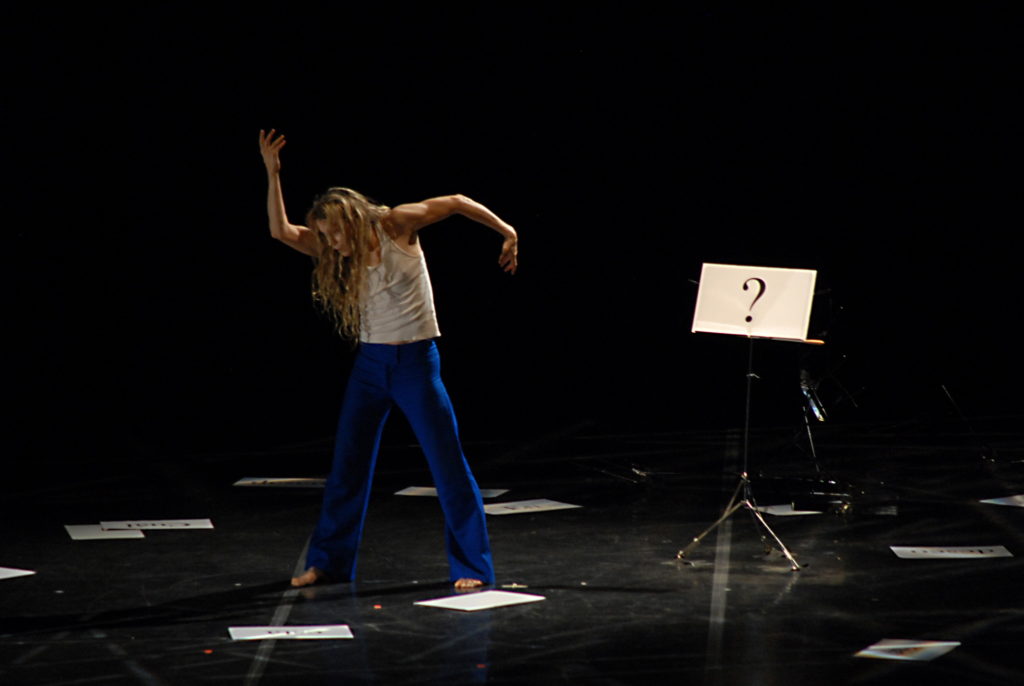
Throughout its history, ballet has been not only a colonialist but also a heteronormative art form, meaning that the love stories of ballet’s plots are nearly always between a woman and a man. Although ballet has used cross-dressing and there are even some references to same-sex love, deviation from the norm has usually been portrayed in a very negative way or obscured to near-invisibility – especially during the twentieth century. For example, in John Neumeier’s (b. 1939) ballet Illusions – like Swan Lake (1976), the character of the Mad King can be read as a purely heterosexual male role. Similarly, the female couple, the grey girls in Bronislava Nijinska’s Les Biches (1924) is frequently ignored as mere friendship between the two women.
Whereas the male homosexual has been a stereotype associated with ballet, the lesbian woman has been thoroughly excised from the art form. The American choreographer Katy Pyle (b. undisclosed) founded the first dance company for non-heterosexual female dancers, Ballez, in 2011.[39] As society has become more tolerant of sexual minorities, the characters and narratives of earlier ballets have been queered. However, ballet still often legitimises not only colonialist but also sexist conventions – such as casting men as “ugly” women – by invoking the “tradition” of the art form. In recent years, many of ballet’s artistic directors and choreographers have been accused of sexual harassment and of creating oppressive, unhealthy work environments.
Ballet’s strict norms of physicality have now started to break down. Famous ballerinas have openly discussed eating disorders and other pitfalls of their profession, and dance educators and companies have started to pay attention to dancers’ general wellbeing and body care.[40]

Ever since the 1960s, the Dance Theatre of Harlem and other Black dance companies have played a significant role in both ballet education and in challenging white normativity. With this in mind, the American choreographer Alonzo King founded his multicultural ballet company LINES in 1982. As its name suggests, LINES focuses heavily on abstract ballet, making new, critically reflective versions of classics.[41] While racism has by no means disappeared, the internal segregation of dance into white and “other” histories and racially segregated groups is breaking down. Discrimination is no longer silenced as it once was.
Despite all this, ballet has rightly been criticised as an art form stuck in old-fashioned attitudes, reproducing outright racist stereotypes.[42] At the time of writing, the Finnish National Ballet’s repertoire includes both the Orientalist Le Corsaire and Pär Isberg’s (b. 1955) choreography Pippi Longstocking (2005), which is even more colonialist than the 1940s children’s books that serve as its source. In the ballet, only the white characters have names and authority, and on the “South Sea” island ruled by Pippi’s father, the “natives” in brownface perform choreography that incorporates stereotypical elements from the dances of various Pacific cultures. Non-white dancers who have fought their way to professional and even star status in ballet still face constant typecasting and racism, especially when trying to address the malpractices of the art form.[43]
Ballet class
The primary purpose of a ballet class is to condition the dancing body with a constant awareness not only of the body’s posture (proprioception) but also of its orientation in space and the lines formed by the body from the top of the head and fingertips through the torso to the toes. Ballet thus still follows the ideal of the aristocratic body dating back to the Baroque period. The allongé, or extended, outstretched arms, accompany the usually equally extended, outstretched legs. Turn-out from the hips, which turns the knees and legs outward from the centre, allows for an expanded range of movement and quick turns. The five base positions and the basic movements founded on them develop the muscles, balance and endurance required for more demanding movements such as pirouettes and jumps. Repetition is therefore a key element of ballet pedagogy, and nowadays, in addition to basic classes, a great deal of body care is included to avoid injuries and prolong the careers of professional dancers.
The structure of the ballet class emerged in the 1700s, when Noverre and Pierre Gardel (1758–1840) began to unify the content of the classes and distinguish the techniques of men and women into separate entities. As a result, mime and expression are often taught outside the basic class, as for character dances. All ballet movements have French names and they are codified from the vertical centre line of the body to the front, back, sides or the quarters between them, as if the centre of the dancer’s body were the centre of a compass divided into sixteen points.[44]
In the nineteenth century, the content of ballet classes was more or less established in the two-part model that is used today. The class starts with basic movements built around a barre and progresses to larger movements using the entire space of the studio. Because the barre is intended to serve as a warmup exercise, to increase flexibility and to refine basic movements, it is structured around repetition and exercises both left and right sides to achieve maximum balance of strength, mobility and accuracy. The movements therefore always progress symmetrically, from smaller to larger, and the repetitions typically accelerate as the class progresses. The initial plié movesare followed by beats (battements)and turned-out leg rotations (ronds de jambe), first against the floor and later with the leg in the air (développé). The faster, sharper beats (frappé) and larger grands battements are always performed only at the end of the barre section.
Barre is followed by floor work, known as au milieu. This part of the class is typically divided into three parts: the adagio part tostrengthen balance, lines of the body and strength with slow movements; followed by pirouettes; and the final fast allegro parttrains the precision and strength required for jumping. Like the barre, au milieu progresses from slow to fast movement, and as such, it develops endurance, since the most intensive movements are typically not performed until the end of the class.
Conclusion
The history of ballet can be seen to reflect wider cultural and historical changes in Europe and the continent’s position in relation to the rest of the world. The stories that we tell about the past shape our future, so it is time to reassess the story that ballet tells about itself. The history of dance in the twentieth century has distorted our understanding of who danced, who was valued as a dancer, where dance was performed and for whom.
At any time, what remains of the past are but fragments, and these can be interpreted in different ways depending on the context in which they are placed and the overall picture thus constructed. From the perspective of cultural history, it is usually more important to notice what is missing from the source materials or historical narrative. Whose history is being told, who is being silenced and why? In the twenty-first century, both new research methods and ballet dancers’ own activism have led to a reassessment of the tones of ballet pedagogy and the many structural problems of the art form. These same ethical voices have changed ballet’s narrative about its past. More recent research has highlighted anomalies and abuses as well as previously overlooked choreographers and dancers whose example can give new meaning to ballet’s long, Eurocentric history.
Notes
1 E.g., Moureau 2005; Powers 2014, esp. 16–17.
2 Franko 1993; Cowart 2008.
3 Nevile 2008, esp. 35; Bloomfield & Watts 2008, 608.
4 Wagner 1997.
5 Sowell et al. 2016.
6 Arbeau 1589.
7 Nye 2011; Ralph 1985.
8 Rameau 1748.
9 On this later dance culture, see Buckland 2011.
10 See, e.g., Weber 1992, esp. vii–viii.
11 Genné 2000.
12 Foster 1996
13 Chazin-Bennahum 2005.
14 Noverre 1760.
15 E.g., Surits 1998, 18–20, 24–25.
16 Smith 2007; Berlanstein 2001.
17 Berlanstein 2001.
18 Blasis 1820 and Blasis 1830.
19 Battersby 1989.
20 Smith 2007.
21 Smith 2007; Berlanstein 1996.
22 Ries 1979; Smith 2000.
23 Smith 2000.
24 Wagner 1849/1895.
25 Gutsche-Miller 2015, esp. 302n20.
26 Gutsche-Miller 2015.
27 Guest 1992; Carter 2005.
28 Wiley 1985; Scholl 2004.
29 Barker 1994.
30 Scholl 2004.
31 See Järvinen 2014; Järvinen 2020.
32 Genné 2000.
33 Genné 2000.
34 Frame 2000, esp. 153–175; Souritz 1990; Sporton 2013.
35 Franko 2020.
36 Laakkonen et al. 2021 is the first comprehensive publication on the 100-year history of the Finnish National Ballet.
37 Croft 2015, esp. 57–61.
38 Cf. Kealiinohomoku 1969/2001.
39 Alterowitz 2021.
40 Kirkland & Lawrence 1986/1987; Copeland 2014; Kauppila 2012.
41 Jensen 2008.
42 Järvinen 2020; Akinleye 2021.
43 E.g., Bourne 2017; Brown 2018.
44 https://fi.wikipedia.org/wiki/Luettelo_balettitermeistä
Literature
Akinleye, Adesola, ed. 2021. Re:Claiming Ballet. Bristol: Intellect.
Alterowitz, Gretchen. 2021. “Feminist Practices in Ballet: Katy Pyle and Ballez.” In Kathrina Farrugia-Kriel and Jill Nunes Jensen, eds. The Oxford Handbook of Contemporary Ballet. New York, NY: Oxford University Press.
Arbeau, Thoinot. 1589. Orchesographie, et traicte en forme de dialogue, par lequel toutes personnes peuvent facilement apprendre & practiquer l’honneste exercice des dances. Lengres: Iehan des Preyz. https://www.loc.gov/item/55003658/
Barker, Barbara. 1994. “Imre Kiralfy’s Patriotic Spectacles: ‘Columbus, and the Discovery of America’ (1892–1893) and ‘America’ (1893).” Dance Chronicle 17:2, 149–78.
Battersby, Christina. 1989. Gender and Genius: Towards a Feminist Aesthetics. London: The Women’s Press.
Berlanstein, Lenard R. 1996. “Breeches and Breaches: Cross-Dress Theatre and the Culture of Gender Ambiguity in Modern France.” Comparative Studies in Society and History 38(2): 338–69.
Berlanstein, Lenard R. 2001. Daughters of Eve: A Cultural History of French Theater Women from the Old Regime to the Fin de Siècle. Cambridge, MA: Harvard University Press.
Blasis, Carlo. 1820. Traité élémentaire, théorique, et pratique de l’art de la danse. Milano: Joseph Beati & Antoine Tenenti.
Blasis, Carlo. 1830. The Code of Terpsichore. Trans. R. Barton. London: Edward Bull.
Bloomfield, Anne & Watts, Ruth. 2008. “Pedagogue of the dance: the dancing master as educator in the long eighteenth century.” History of Education 37(4): 605–618.
Bourne, Sandie Mae. 2017. “Black British Ballet: Race, Representation and Aesthetics.” Dissertation, Department of Dance, University of Roehampton, UK.
Brown, Lauren Erin. 2018. “‘As Long as They Have Talent’: Organizational Barriers to Black Ballet.” Dance Chronicle 41(3): 359–392.
Buckland, Theresa Jill. 2011. Society Dancing: Fashionable Bodies in England, 1870–1920. Basingstoke: Palgrave Macmillan.
Carter, Alexandra. 2005. Dance and Dancers in the Victorian and Edwardian Music Hall Ballet. London: Routledge.
Chazin-Bennahum, Judith. 2005. The Lure of Perfection: Fashion and Ballet, 1780–1830. London: Routledge.
Copeland, Misty. 2014. Life in Motion: An Unlikely Ballerina. New York, NY: Touchstone.
Cowart, Georigia J. 2008. The Triumph of Pleasure: Louis XIV and the Politics of Spectacle. Chicago, IL: University of Chicago Press.
Croft, Clare. 2015. Dancers as Diplomats: American Choreography in Cultural Exchange. New York, NY: Oxford University Press.
Feuillet, Raoul-Auger. 1709. Recueil de dances. Paris: L’auteur. https://www.loc.gov/item/14002125/
Foster, Susan Leigh. 1996. Choreography & Narrative: Ballet’s Staging of Story and Desire. Bloomington, IN: Indiana University Press.
Frame, Murray. 2000. The St. Petersburg Imperial Theaters: Stage and State in Revolutionary Russia, 1900–1920. Jefferson, NC: McFarland & Co.
Franko, Mark. 1993. Body as Text: Ideologies of the Baroque Body. Oxford: Oxford University Press.
Franko, Mark. 2020. The Fascist Turn in the Dance of Serge Lifar: Interwar French Ballet and the German Occupation. New York, NY: Oxford University Press.
Genné, Beth. 2000. “Creating a Canon, Creating the ‘Classics’ in Twentieth-Century British Ballet.” Dance Research 18(2): 132–162.
Gottschild, Brenda Dixon. 2003. The Black Dancing Body: A Geography from Coon to Cool. Basingstoke: Palgrave Macmillan.
Guest, Ivor Forbes. 1992. Ballet in Leicester Square: The Alhambra and the Empire, 1860–1915. London: Dance Books.
Gutsche-Miller, Sarah. 2015. Parisian Music-Hall Ballet, 1871–1913. Rochester, NY: University of Rochester Press.
Jensen, Jill Nunes. 2008. “Outlines for a Global Ballet Aesthetic.” Dance Chronicle 31(3): 370–411.
Johnson, James H. 1995. Listening in Paris: a cultural history. Los Angeles, CA: University of California Press.
Järvinen, Hanna. 2014. Dancing Genius: The Stardom of Vaslav Nijinsky. Basingstoke: Palgrave Macmillan.
Järvinen, Hanna. 2020. “Ballets Russes and Blackface.” Dance Research Journal 52(3): 76–96.
Kauppila, Heli. 2012. Avoimena aukikiertoon: Opettajan näkökulma kokonaisvaltaiseen lähestymistapaan baletinopetuksessa. Acta Scenica 30. Teatterikorkeakoulu: Helsinki.
Kealiinohomoku, Joann. 1969/2001. “An Anthropologist Looks at Ballet as a Form of Ethnic Dance.” In Ann Dils & Ann Cooper Albright, eds. Moving History/Dancing Cultures: A Dance History Reader. Middletown, CT: Wesleyan University Press, 33–43.
Kirkland, Gelsey and Greg Lawrence. 1986/1987. Dancing on My Grave: An Autobiography. New York, NY: Jove Books.
Laakkonen, Johanna, Aino Kukkonen, Raisa Rauhamaa, Riikka Korppi-Tommola and Tiina Suhonen, eds. 2021. Se alkoi joutsenesta: Sata vuotta arkea ja unelmia Kansallisbaletissa. Hämeenlinna: Karisto.
Moureau, François. 2005. Le théâtre des voyages: une scénographie de l’âge classique. Paris: Presses du Paris Sorbonne.
Nevile, Jennifer, ed. 2008. Dance, Spectacle, and the Body Politick, 1250–1750. Bloomington, IN: Indiana University Press.
Noverre, Jean Georges. 1760. Lettres sur la danse, et sur les ballets. Stuttgart and Lyon: A. Delaroche. https://www.loc.gov/item/08017354/
Nye, Edward. 2011. Mime, Music and Drama on the Eighteenth-Century Stage: The Ballet D’Action. Cambridge: Cambridge University Press.
Powers, David M. 2014. From Plantation to Paradise? : Cultural Politics and Musical Theatre in French Slave Colonies, 1764–1789. East Lansing, MI: Michigan State University Press.
Ralph, Richard. 1985. The Life and Works of John Weaver: An Account of His Life, Writings and Theatrical Productions, with an Annotated Reprint of His Complete Publications. London: Dance Books.
Rameau, Pierre. 1748. Le maître à danser, Qui enseigne la maniere de faire tous les differens pas de danse dans toute la régularité de l’art, & de conduire les bras à chaque pas. Paris: Rollin fils. https://www.loc.gov/item/10019566/
Ries, Frank W. D. 1979. “In Search of Giselle: Travels with a Chameleon Romantic.” Dance Magazine, August, 59–74.
Scholl, Tim. 2004. ‘Sleeping Beauty’: A Legend in Progress. New Haven, CT: Yale University Press.
Silver, Kenneth E. 1989. Espirit de Corps: The Art of the Parisian Avant-Garde and the First World War, 1914–1925. Princeton and London: Princeton University Press and Thames and Hudson.
Smith, Marian. 2000. Ballet and Opera in the Age of Giselle. Princeton, NY: Princeton University Press.
Smith, Marian. 2007. “The disappearing danseur.” Cambridge Opera Journal, 19(1): 33–57.
Sporton, Gregory. 2013. “The Conservative Revolution: The Bolshoi Archives.” Scene 1(1): 85–98.
Souritz, Elisabeth. 1990. Soviet Choreographers in the 1920s. Lynn Visson. London: Dance Books.
Sowell, Madison U. & Sowell, Debra H. & Falcone, Francesca & Veroli, Patrizia. 2016. Icônes du ballet romantique: Marie Taglioni et sa famille. Rome: Gremese.
Surits, E. [Souritz, Elisabeth]. 1998. The Great History of Russian Ballet: Its Art and Choreography. Translated by. V. Arkadyev, I. Bershadsky, F. Kreynin and R. Coalson. Bournemouth: Parkstone Press.
Wagner, Richard. 1849/1895. “The Art-Work of the Future.” In volume 1. Translated by William Ashton Ellis. S.l., 69–213. The Wagner Library http://users.belgacom.net/wagnerlibrary/prose/wagartfut.htm Accessed 21 July 2005.
Wagner, Ann. 1997. Adversaries of Dance: From the Puritans to the Present. Urbana, IL: University of Illinois Press.
Weber, William. 1992. The Rise of Musical Classics in Eighteenth-Century England: A Study in Canon, Ritual, and Ideology. Oxford: Clarendon Press.
Wiley, Roland John. 1985. Tchaikovsky’s Ballets: Swan Lake, Sleeping Beauty, Nutcracker. Oxford: Clarendon Press.
Contributor
Hanna Järvinen
Hanna Järvinen a university lecturer and department head at the Performing Arts Research Centre of the Theatre Academy, docent in dance history at the University of Turku, and Honorary Visiting Research Fellow at De Montfort University in Leicester. She has researched authorship and genius as well as the performing arts canon and the use of power in the light of feminist and postcolonial research traditions. She is also interested in issues of modernity and materiality at the intersection of performance and performing arts and dance orcid.org/0000-0001-9081-9906.